☫ 41 countries around the world: Africa, Asia, Oceania, South America
What is the definition of a “minor navy” ?
Surely there is a “top tier”, which is most often assimilated to a “blue water navy”. And it is most often assorted with a true aircraft carrier (not an assault ship), which gave us a limited club (USN, and Russian Navy, British, French, Italian and Spanish Navies, and in Asia the PLAN, JSDMF, Indian and Thai Navies). Then came “regional navies” sometimes flagged as “green water” navies, which in high tier have guided missile destroyers and assault ships (like Turkey) while the Bundesmarine have not, and they could still make a projection of power due to large ships with logistic for oceanic operations such as anti-piracy missions in the red sea. And these is the lower tier, which could defend its EEZ and do limited projection of powers nearby but not much esle, which is the object of the present chapter.
And there is at the bottom what most calls a “brown water” navy. The name suggest essentially a riverine fleet. It’s especially true of the country had still a limited coastal area but restricted budget and/or is landlocked and only has a complement to just a “police force” for its riverine traffic. This is true also for large lakes, like the Tanganyka in Africa. Still between the low tier regional naval power to the small riverine force, enters most nations on the planet. They are classed by alphabetical order. It must be said that 44 countries in the world (on 195 recoignised ones worldwide) are truly landlocked. Let’s cite Afghanistan, Andorra, Armenia, Austria, Czechia, Hungary, Liechtenstein, Luxemburg, Montenegro, North Macedonia, Serbia, Slovakia, Slovenia, Switzerland, in Europe alone, but also Azerbaijan, Belarus, Bhutan, Bolivia, Botswana, Burkina Faso, Burundi, Central African Republic, Chad, Eswatini, Ethiopia, Somaliland, Kazakhstan, Kosovo, Kyrgyzstan, Laos, Lesotho, Malawi, Mali, Moldova, Mongolia, Nepal, Niger, Paraguay, Rwanda, Slovakia, South Ossetia, South Sudan, Tajikistan, Transnistria, Turkmenistan, Uganda, Uzbekistan, Vatican, Zambia and Zimbabwe. In population, 475,818,737 so 6% roughly of the world’s population, showing superbly that the bulk of humanity lives close to the sea. Many of these only have a token riverine police force or nothing at all, even with a small river going through, nike Nepal. These are absent of the list but could be added next year.
About this page:
I will complete these fleets according to a monthly schedule, one after the other in the following years, and add more along the way. The ones not present are of course to be looked for in the main menu.
 Algerian Navy
Algerian Navy
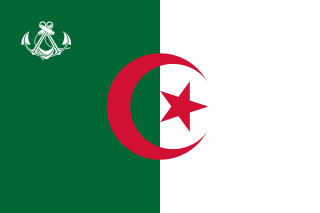 The Algerian Naval Force (القوات البحرية الجزائرية) is the naval branch of the Algerian military, founded after the Independence in 1963, but existing in various guises from 1516 to 1827. This navy operated from bases along the country’s 1,440 km (890 mi) coastline. Primary mission is to defend Algeria’s territorial waters and EEZ, fishery areas and strategic geological assets (potential oil extraction) against foreign intrusions. There is no dedicated coast guard and all maritime safety missions are tasked by the Navy, with a wide range of ships between a 9000 tonnes LHD down to small patrol boats. Projection of forces comprises an amphibious component (three main vessels) plus a corps of “fusiliers marins” (Marines), an air components (16 helicopters), 20 to 25 Frigates and corvettes, a conventional deterrence with six submarines, making the Algerian a top-tier player in the Western Mediterranean, and “blue-green” water navy.
The Algerian Naval Force (القوات البحرية الجزائرية) is the naval branch of the Algerian military, founded after the Independence in 1963, but existing in various guises from 1516 to 1827. This navy operated from bases along the country’s 1,440 km (890 mi) coastline. Primary mission is to defend Algeria’s territorial waters and EEZ, fishery areas and strategic geological assets (potential oil extraction) against foreign intrusions. There is no dedicated coast guard and all maritime safety missions are tasked by the Navy, with a wide range of ships between a 9000 tonnes LHD down to small patrol boats. Projection of forces comprises an amphibious component (three main vessels) plus a corps of “fusiliers marins” (Marines), an air components (16 helicopters), 20 to 25 Frigates and corvettes, a conventional deterrence with six submarines, making the Algerian a top-tier player in the Western Mediterranean, and “blue-green” water navy.
 Due to weapons procurement during the war of independence just as other Algerian military branches, Soviet assistance shaped its navyfor ships types and structure during the Cold War, but more recently, Algeria started to seek for other sources for equipment, including major ships: Germany, China, Italy, France, UK, Spain, Japan, Poland and Norway…
Due to weapons procurement during the war of independence just as other Algerian military branches, Soviet assistance shaped its navyfor ships types and structure during the Cold War, but more recently, Algeria started to seek for other sources for equipment, including major ships: Germany, China, Italy, France, UK, Spain, Japan, Poland and Norway…
Algeria also invested its own shipbuilding capacity. Based on this, Algerian built its first domestic ships, the Djebel Chenoua class corvettes in 2002, but during the cold war procurement was almost exclusively Soviet. This article thus will be split in two, the cold war and modern navies, plus plans.
The Algerian Navy in the cold war
The Algerian armed forces (including a fourth service, the National Gendarmerie) are formidable and well-equipped, much military effort having been devoted to the 150,000-man army, the fourth strongest in Africa, with a reputation and traditions based on winning the prolonged guerrilla war leading to independence in 1962. Algeria’s merchant marine, boosted like much else by the country’s recent oil wealth, expanded from seventy-five ships (239,81 5grt) in 1974 to 130 vessels (1,218,621 grt) in 1980.
The navy, which began with a pair of Egyptian (ex-US) coastal minesweepers, has been gradually expanded and modernised in the past 25 years, personnel being increased from 3000 to 6000, with about 9000 reservists, and it is now probably stronger and certainly more efficient than the Libyan Navy. Previously a force of large patrol and fast attack craft, it was reinforced 1n 1980 by the first of two Soviet missile corvettes and a ‘Koni’ class frigate, giving some cruising capability. From January 1982 a Soviet ‘Romeo’ class submarine gave training to Algerian crews at Mers-el-Kebir, and in 1987-88 two ‘Kilo’ class submarines were acquired from the Soviet Union to replace the two ‘Romeos’ acquired earlier.
Despite receiving further Soviet equipment, and regular visits from the Soviet fleet, Algeria did not provide the USSR with base facilities. Since the early 1980s, Algeria has started to build its own small surface vessels, but lacks the funds to buy the larger replacement vessels it urgently requires. ‘The main bases along the 800-mile coast are Mers-el-Kebir, Algiers, Arzew, Philippeville, La Senia and Annaba (Bone).
List:
3 Koni class frigates (1980): Built at Zelenodosk SY, launched 1979, pennants 901-903, Murat Reis, Rais Kellicen, Rais Korfu. Still in service today.
2 Romeo class submarines (delivered 1982-83). From 1995, battery-charging boats and pierside training hulks.
2 Kilo class submarines Delivered 1987-88. The sail has a mount for Strela SAM MANPAD aft (30 in reserve). Extant.
3 Nanuchka II class corvettes: Built at Petrovksky, Leningrad, launched 1979, delivered 1980-81 as Rais Hamidou, Salah Reis and Rais Ali, pennants 801-803. Extant
c14 Kebir class OPVs (see below)
12 OSA I/II class FACs: Transfers: 3 1967, 9 1976-81 numb.644-651, one damaged, one destroyed explosion 1981. Stricken 2000s.
6 Komar class FACs: Transferred 1966 as 671-676, stricken 1995.
12 P6 class FAC(Torpedo): Transferred 1963-68, discarded 1975 to 1984, 2 Coast Guard, 2 training.
6 SO-I class OPVs: Transferred 1965-67 P651-656, three had 2x TTs from P6s. Discarded 1985-88
6 Hainan class OPVs: Transferred 1990 and used by the coast guards.
2 BYMS type Minesweepers: Djebel Aures, Sidi Fradj, from Egypt 1962, Aures wrecked off Algiers 1963, Fradje discarded 1971.
2 T43 class minesweepers: Transferred 1968, discarded 1984-85
1 Polocny class transferred 1976, N°555
1 Poluchat class Torpedo recovery vessel
1 Zhuk class 1981 CPC.
16 CPS 1976 Italian built for the Coast Guard. Discarded;
The Algerian Navy today and plans
Current list in 2023:

Kalaat Beni Hammed in 1984
-2 Kilo, 4 Kilo-M class subs
-Kalaat Béni Abbès (San Giorgio class LSD ordered 2011, com. 2015)
-2 Kalaat Beni Hammed class landing ship, UK built, com. 1984
-2 Erradii class, German MEKO 2000 Frigates com. 2016: Erradii, El Moudamir
-3 Adhafer class frigates, Chinese 2880t stealth corvettes, com. 2015: Adhafer, El Fatih, Ezzadjer
-3 Koni class (see above) modernized in 2011: Mourad Rais, Rais Kellik, Rais Korfou
-3 Nanuchka II class corvettes, modernized 2012: Ras Hamidou, Salah Reis, Reis Ali
-4 Djebel Chenoua class corvettes (algerian built, com. 2002, see below ): Djebel Chenoua, El Chihab, El Kirch, Hassan Barbiear
-1(6) El Moutassadi class corvettes (Chinese 1500t Type 056 class): Sources differs 1 or 6 delivered, no names but lead ship.
-3 Steregushchiy class corvettes on order (to be delivered 2022).
-3 El-Kasseh class mine countermeasure ships (Italian Lerici class, com. 2016)
-8 Osa II-class missile boats (possibly in reserve today, still listed)
-14 Kebir-class OPVs (UK built, com. 1982, by Booke Marine)
-41 Denebi class OPVs (Fr Ocea-class patrol boats, com. 2008-2021)
-12 El Mounkid class CPVs (Algerian built wt Spanish & assistance design, com. 2016)
-El Idrissi survey ship 540t 1980 (Japan built Matsukara Zosen)
-El Masseh survey ship (Fr Ocea Yd OSV-95 type) com. 2021
-Soummam TS (Chinese built 5,500 tonnes com 2006)
-EL Mellah Polish built sailing vessel Gdansk 2006.
-El Mourafik 600t salvage vessel Chinese built 1990
-El Mounjid class High Seas tugs (Norway built 3,200 tonnes Type UT 515 CD 2012)
Naval Air Force:
-10 Westland Super Lynx, ship and land borne, ASW helicopters
-5 Agusta-Westland AW101 for SAR helicopters
-3 Agusta-Westland AW139 utility helicopters
Future plans:
-Acquisition of TYPE 054A 2+ frigates 2020s
-Acquisition of 4-6 AIP Submarines in replacement to the Kilos, late 2020s.
-3 Three corvettes C28A +3 more locally. Thales electronics mounted in Algeria, Hudong Zhonghua Shipyard
 Kalaat Béni Abbès (2014)
Kalaat Béni Abbès (2014)
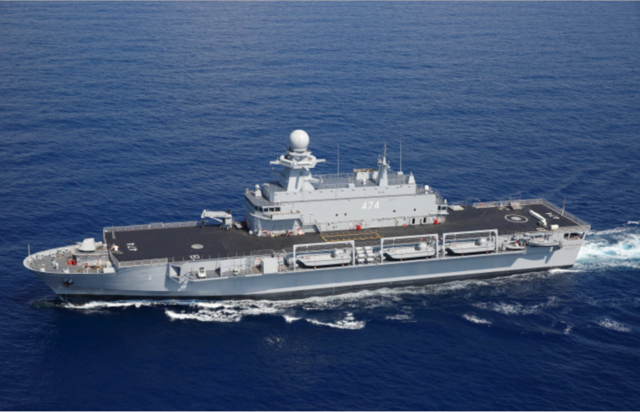
Modified San Giorgio class: Ordered 2011 +one option. Delivered 2015. 9,000 tonnes, Improved San Giorgio Landing and Logistic Support Ship. The BDSL can accommodate 3 landing craft mechanized, 3 small landing craft vehicle personnel, 1 large landing craft personnel, 2 semi-rigid boats 15 armoured vehicles in hangar, helideck, 6 spots, crew 150, 400 troops. Armament: Aster 15 missiles, 1x OTO Melara 76 mm Super Rapido, bow; 2x 25 mm RWS.
 Erradi class Frigates (2015)
Erradi class Frigates (2015)
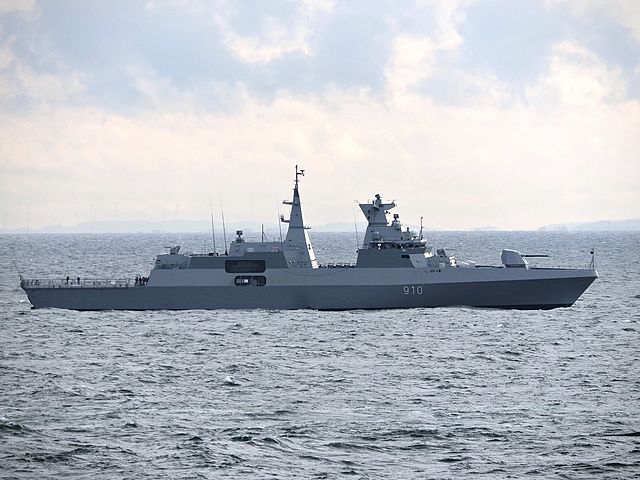
Two MEKO A-200AN frigates: Erradii (910) and El Moudamir (911) ordered from ThyssenKrupp Marine Systems, then ADM Kiel shipyard in 2013 plus option for two more in 2014 and is fitted with the following:
-Oto Melara 127/64 LW 127 mm main gun
-MSI-Defence 30 mm cannons
-Denel Dynamics Umkhonto-IR surface-to-air missiles
-Saab/Diehl Defence RBS-15 Mk3 anti-ship missiles
-Rheinmetall Defence MASS softkill decoy launchers
-Saab Sea Giraffe AMB 3-D surveillance radar
-Saab CEROS 200 radar/electro-optical fire control directors
-Thales UMS4132 Kingklip sonar
CODOG with GE turbine or CODAG-WARP (WAter jet and Refined Propellers) propulsion like the 200SAN
 Djebel Chenoua-class corvettes
Djebel Chenoua-class corvettes
Djebel Chenoua, El Chihab, El Kirch, Hassan Barbiear
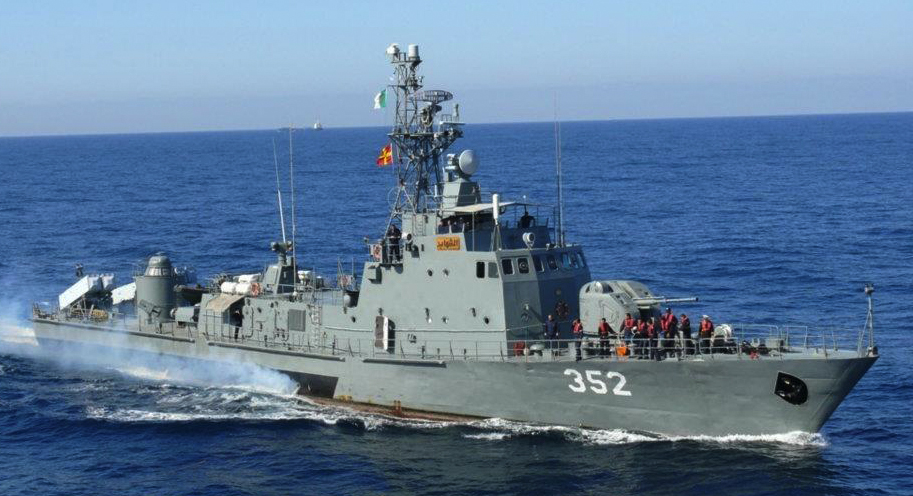
First large Algerian built vessels. Next ones are the Alusafe 2000 speedboats and potentially in the future, chinese design corvettes C28A.
The Djebel Chenoua-class corvettes are of domestic design and assembly, developed in ERCN Mers el-Kebir shipyard near Oran, built in the 1980s. They were specialized in ASW and SAR operations, lightly armed until equipped with four C-802 missiles made in China, derived from the French Exocet (120 km range, auto guidance). It is completed by a Russian AK-176 76 mm main gun and Gatling-type AK-630 30 mm for air defense aft.
Specs: 550 tons FL, 58.4 x 8.5 x 2.59m (191.6 x 27.9 x 8.5 ft), 3× MTU 20V-538-TB92 diesels, 31 knots RA 1.000 Nmi (1.852 km) Crew 52, carried 2 Rigid-hulled inflatable boat
Attack radar Type 363A/S, Acquisition radar Type 374G, Optronic director Type 88C, 2 × Decoy launchers.
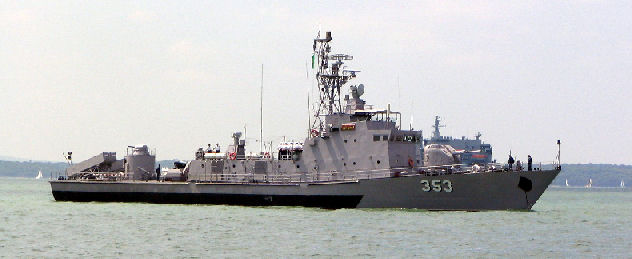
El Kirch in 2006
Sources:
J. Gardiner, Conway’s all the world’s fighting ships 1947-95
mdn.dz/ official site
Algerian_Navy
 Azerbaijani Navy
Azerbaijani Navy
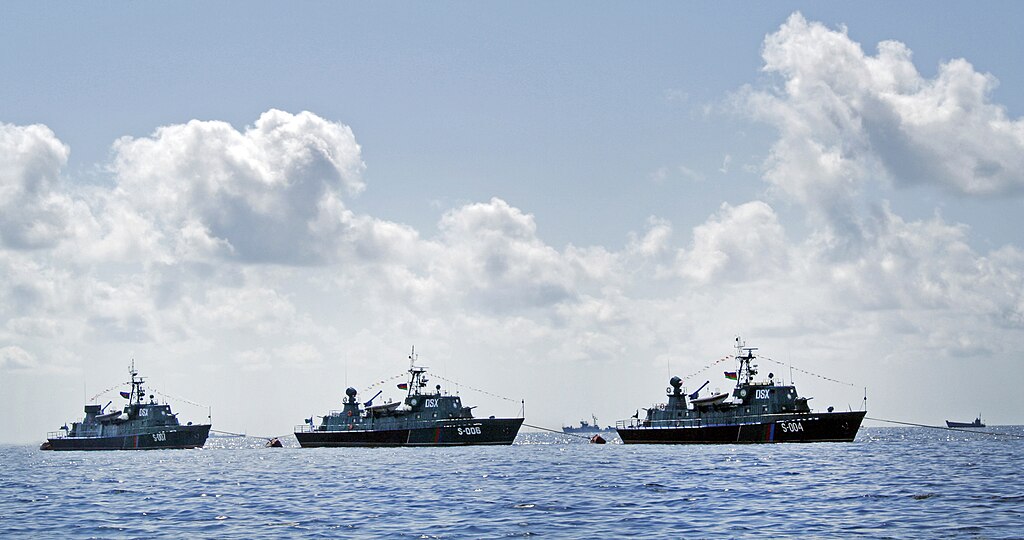
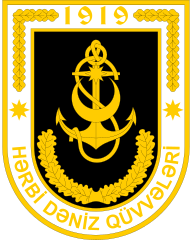 The Azerbaijani Naval Forces wer created back in August 5, 1919, as the government of the Azerbaijan Democratic Republic established a naval force, based on remnants of the Russian Imperial fleet of the Caspian Sea. To remind, Azerbaijan was at first part of Caucasian Albania and Persian empires while in the 19th century as part of Qajar Iran, the country was claimed by Russia after the Russo-Persian wars of 1804–1813 and 1826–1828. The treaties of Gulistan in 1813 and Turkmenchay in 1828 precised borders with what was called Qajar Iran and fell under the Caucasus Viceroyalty.
The Azerbaijani Naval Forces wer created back in August 5, 1919, as the government of the Azerbaijan Democratic Republic established a naval force, based on remnants of the Russian Imperial fleet of the Caspian Sea. To remind, Azerbaijan was at first part of Caucasian Albania and Persian empires while in the 19th century as part of Qajar Iran, the country was claimed by Russia after the Russo-Persian wars of 1804–1813 and 1826–1828. The treaties of Gulistan in 1813 and Turkmenchay in 1828 precised borders with what was called Qajar Iran and fell under the Caucasus Viceroyalty.
By the late 19th century a raise of nationalism saw the grow of Azerbaijani national identity. Revolts ended with the Azerbaijan Democratic Republic proclaimed as an independent state from the Transcaucasian Democratic Federative Republic in 1918, helped by the revolution and collapse of the Russian Empire.

Erdogan, 1919 former Russian vessel.
This small navy had only 6 ships. However soon Soviet rule was established in Azerbaijan, and the navy was transferred under the Soviet Navy supervision. The country lived on as a republic of the USSR but no longer control of its defence, until 1991 and the collapse of the Soviet Union.
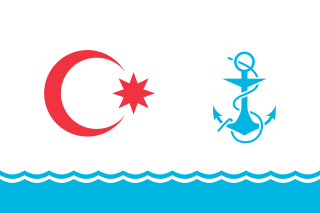 During the cold war, AZERBAIJAN A naval force was set up in July 1991, based at Baku on the Caspian Sea. It had been decided that half of the former Soviet Caspian Sea flotilla would be divided between Russia and Azerbaijan, with the other half to be shared later between Turkmenistan and Kazakhstan. Other units came from the KGB Border Guards. The following vessels were reported extant in 1995:
During the cold war, AZERBAIJAN A naval force was set up in July 1991, based at Baku on the Caspian Sea. It had been decided that half of the former Soviet Caspian Sea flotilla would be divided between Russia and Azerbaijan, with the other half to be shared later between Turkmenistan and Kazakhstan. Other units came from the KGB Border Guards. The following vessels were reported extant in 1995:
-One ‘Petya II’ class frigate, 404 (ex-SKR-16), transferred 1992.
-One ‘Polnocny B’ class medium landing ship, transferred August 1992.
-Three ‘Polnocny A’ class medium landing ships, transferred August 1992 from the Caspian flotilla. Believed to be in poor condition.
-One ‘T 4’ class landing craft transferred July 1992.
-Two “Osa II’ class fast attack craft (missile), transferred August 1992, one believed to have been a training vessel prior to transfer.
-One “Zhuk’ class coastal patrol craft.
-Two ‘Stenka’ class fast attack craft (torpedo). Transferred July 1992 from KGB Border Guards. Likely that sonar and ASW TT removed.
-Three ‘Sonya’ class coastal minesweepers transferred August 1992.
-Two ‘Yevgenya’ inshore minesweepers transferred 1992.
The Azerbaijani fleet of the Soviet Navy was divided between Azerbaijan and the Russian Federation. By July 1992, Azerbaijani ships saw ceremonies with the raising of the Azerbaijani Flag in the Caspian Sea. The 1996 Presidential Decree by Heydar Aliyev marked August 5 as national “navy day”. Reinforced thanks to a rsisng budget favoured by the country’s rveneus from petroleum, this fleet is now second strongest navy in the Caspian Sea, after the Russian fleet flotilla.
Jane’s Fighting Ships precised a Coast Guard was formed in July 2002, requisitioning vessels from the Caspian Flotilla and Border Guard. In 1995 Russian overall control was re-established for “maintenance and support” although independence is still nominal. The Navy today is commanded by Captain Rafig Asgarov.
Naval Bases and installations:
-Baku (Puta) Naval Base: Shipyard close to Puta, Qaradagh. Puta is the largest military facility in the Caspian Sea, built from October 2010. Main support, HQ, academic center are all located at the same place, with arsenal, drydocks and repair Plant of the Navy. The old Soviet Naval base in Baku, dilapidated after the fall of USSR, had been converted into a arts centre.
Zığ base: Azeri Marines infantry HQ.
Organization:
- Main Headquarters:
- Brigade of Patrol Ships
- Marine Infantry
- Reserve
- Mobilization reserve:
- Educational establishments
Surface Ship Brigade
Water Area Protection Division
Division of Landing Ships
Division of Minesweepers
Division of Search and Rescue Vessels
Training Courts Division
641st Naval Special Operations Brigade
Sea Sabotage and Reconnaissance Brigade
Azerbaijan Coast Guard
Patrol Ship Brigade
Azerbaijan Merchant Fleet
Faculty of the Navy, Azerbaijan Higher Military Academy (the former Azerbaijan Higher Naval Academy) – training of officers of the fleet and naval units of the border troops
Training Center of the Azerbaijani Navy – training of warrant officers and foremen of the contract service.
Strenght Today:
4 submarines, 1 frigate, 13+ patrol vessels, 6 landing craft, 7 mine warfare ships:
-Soviet Triton-2m and Triton-1 (Project 907) submarines: 4 in service
-Soviet Petya-class frigate, ARG Gusar(G121) modernised by USA and Turkey.
 ARG Gusar(G121)
ARG Gusar(G121)
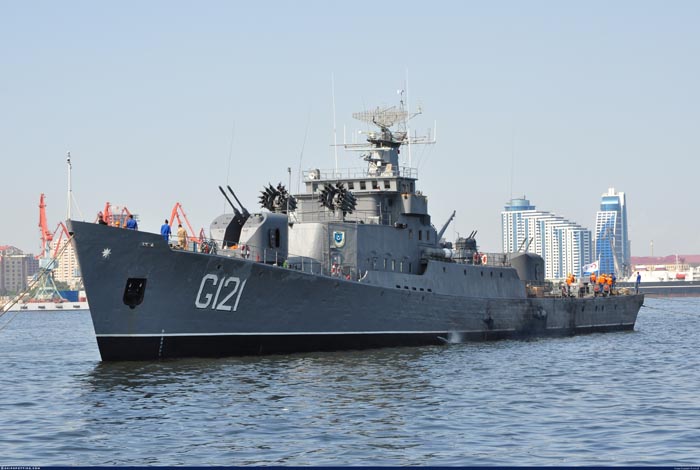
Ex-Grisha class boat. Replacing a former ‘Petya II’ class frigate, 404 (ex-SKR-16), transferred 1992.
 Azeri OPVs
Azeri OPVs
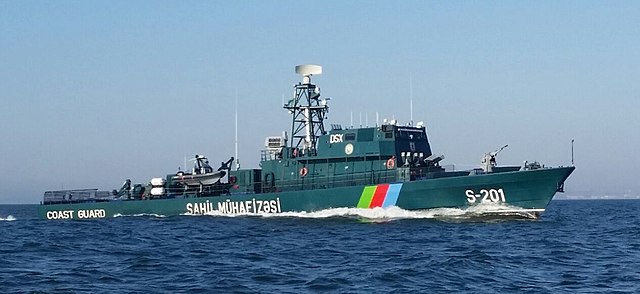
-5 Stenka-class patrol boat
-3 Osa-class fast attack craft (missile)
-2 Svetlyak-class patrol boat
-2 AB-25 class patrol craft: AB-34 (P-134) and AB-35 (P-135) transferred in 2000
-1 Point-class cutter, (S-201 – ex-USCGS Point Brower) from US
In addition, negociations are ongoing to acquire the Kılıç-class fast attack craft with Turkey.
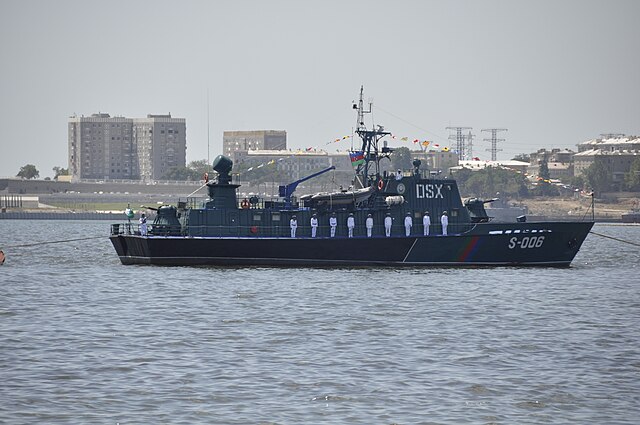
OPVs in the military parade off Baku

US Point-class Cutter S-201
 Azeri landing ships
Azeri landing ships
6 Polnocny-class landing ship: 2 Polnocny-A and 4 Polnocny-B
 Azeri Minesweepers
Azeri Minesweepers
2 Sonya-class minesweeper
5 Yevgenya-class minesweeper
Note: more infos on these when creating the portal page on Soviet cold war minesweepers.
 Azeri Naval Aviation
Azeri Naval Aviation
-3 CASA/IPTN CN-235 HC-144A Maritime patrol planes, twin-turboprop
-2 Eurocopter AS365 Dauphin, SAR and maritime patrol
-1 Eurocopter AS332 Super Puma transport heli
Cooperation programs:
In 2006, the U.S. Government donated three motorboats to the Azerbaijani Navy, together with an agreement to refurbish Azerbaijani warships; By May 19, 2006, Azerbaijani and Turkish Navy held a joint military exercise for the security of oil and gas pipelines, in Baku to ensure the safety of the Baku-Tbilisi-Ceyhan pipeline to provide Caspian oil to Turkey an to terminals for export. The exercises consisted in the clearance of mines on the seabed and counter-terrorism, maritime and air operations.
In 2007, a new agreement was signed between the Azerbaijani Navy and U.S. company to provide advanced laser marksmanship systems and training.
Lastly, the Caspian Guard Initiative was signed as a framework program to coordinate activities in Azerbaijan-Kazakhstan with the U.S. Central Command and other agencies for Caspian security. This also includes counter-terrorism, work to prevent nuclear proliferation, drug and human trafficking, under the EUCOM command.
Sources:
Azerbaijani_Navy
trend.az/life/socium
http://www.lidertv.com
mod.gov.az/en/navy-forces
azernews.az/
eurasianet.org azerbaijan-inaugurates-new-caspian-naval-base
nvo.ng.ru/
today.az/
mod.gov.az/ pdf/
 Bahraini Navy
Bahraini Navy
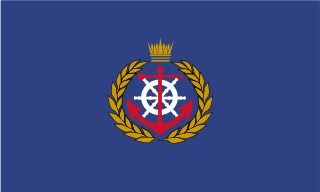 The Royal Bahraini Naval Force (Arabic: القوات البحرية الملكية البحرينية, abbreviated RBNF), was founded in 1979, following an independence on 15 August 1971. Prior to that the country was claimed both by Saudi Arabia and Iran, and was a quasi-protectorate of Britain. The oil-rich country took part in WW2 on the side of the allies. Thew navy grew until comprising today of 700 personnel (crews only), 35 ships and two helicopters. It comprises today one single frigate, the former U.S. Oliver Hazard Perry-class RBNS Sabha.
The Royal Bahraini Naval Force (Arabic: القوات البحرية الملكية البحرينية, abbreviated RBNF), was founded in 1979, following an independence on 15 August 1971. Prior to that the country was claimed both by Saudi Arabia and Iran, and was a quasi-protectorate of Britain. The oil-rich country took part in WW2 on the side of the allies. Thew navy grew until comprising today of 700 personnel (crews only), 35 ships and two helicopters. It comprises today one single frigate, the former U.S. Oliver Hazard Perry-class RBNS Sabha.
Before even the creation of the navy in 1979 indeed, to protect the country from Iran after the revolution, the United States and Bahrain signed an agreement on 23 December 1971 allowing the USN “Middle East Force” to use the former British base. The very first warship arrived on 20 March. The flagship RBNS Sabha was acquired on 9 July 1997.
RBNS Sabha took part in the invasion of Iraq and Operation Enduring Freedom.
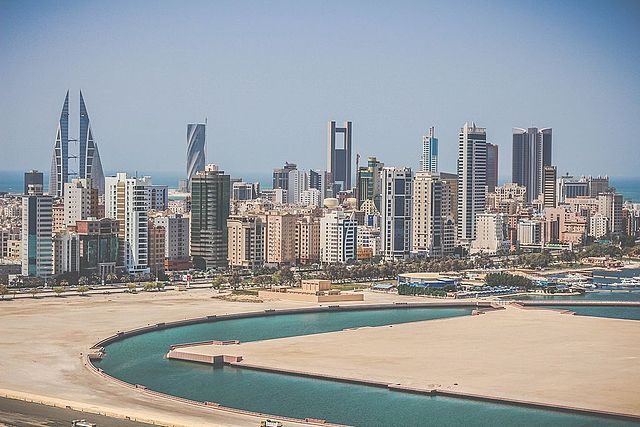
Bahrain consists of a group of low-lying islands situated about twenty miles off the coast of Saudi Arabia. The largest of these is Bahrain, on which the capital, Manama, is situated at the northern end. The population by 1991 estimate was 516,000. A friendship treaty was signed between Britain and Bahrain after independence in 1971.
By 1992 naval personnel had increased to 650 officers and ratings. There are also about 250 men serving in the Coast Guard patrol force. During the 1980s Bahraini naval forces were increased significantly. New acquisitions include two fast helicopter-capable missile armed fast corvettes of the Lurssen ‘FPB 62’ type, commissioned in 1987-88, and four fast attack craft of the Lurssen “TNC 45’ type which entered service in pairs in 1984 and 1986-89.
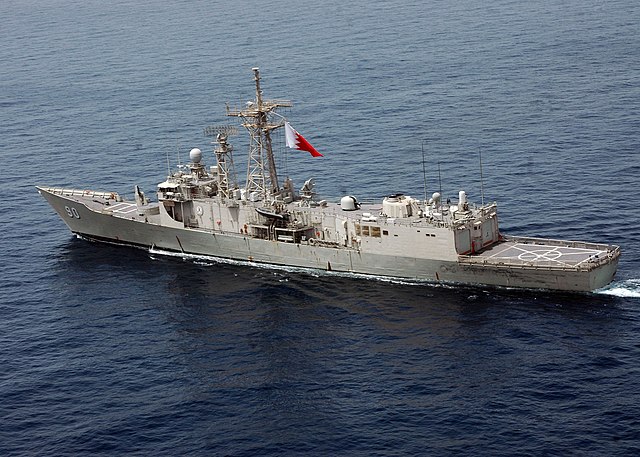
Bases:
Mina Salman Naval Base: Currently shared with the USN 5th Fleet, as ship/sub logistic support, and deom 1980s a cargo facility.
Manama Naval Base: Regional key US Navy installation, former HMS Juffair. The navy shipyard is large wand well provided for various drydock operations and is shared with several other neighbouring countries.
These acquisitions significantly increased the capabilities of the navy bevond its former role as a small coastal patrol force. This build-up can be seen as a success story for Lurssen, as all ships and craft of any fighting value were designed and built by them. During the early 1990s there were reports of the proposed procurement of up to three air cushion minehunters, but nothing has come of this so far. Bahrain continues to play host to Western naval forces in the Gulf. It was also a sanctuary for surviving Kuwaiti warships which fled that country during the Iraqi invasion.
Cold War Ships list
-2 Lürssen FPB 62 missile corvettes (1987): Al Manama, Al Muharraq
-2 Lürssen FPB 38 FACs (1981): Al Riffa, Hawar
-4 Lürssen TNC 45 FACs (1984): Ahmad el Fateh Al Jaberi, Abdul Rahman el Fadel, Al Tameerlah
-2 Swift FPB 20 FACs: Al Jarim, Al Jasrah
-4 LCU (US design from Swiftships, Morgan city): Ajirah, Mashtan, Rubodh, Suwad. 100t fuel, 88t water, bow ramp, 15t crane.
Coast Guard (Ministry of interior command)
-3 Fairey Marine ‘Tracker’ class (26t full load, 64ft, 28kts, 1—20mm): Deraa 1, Deraa 2, Deraa 3: Deraa 1 bought 1974, in service since 1975. Two others bought 1980. Deraa 2 stricken 1990, remainder extant 1995.
-Two Fairey Marine ‘Spear’ class (10t full load, 29ft, 26kts, 2 MG, 3 men): Saham (4) and Khataf (5) bought 1974, in service since 1975.
-Two Vosper type (32t, 56ft, 29kts): Howar (3) and Roubodh, Singapore-built 1977.
-Three small Vosper type (6.3t, 36ft, 27kts): Al Bayneh, Funnan and Quaimas, Singapore-built 1977. All three deleted 1992.
-One 50ft Cheverton type (9t, 22kts): Mashtan (6) UK-built 1976. Deleted 1993.
-Three 27ft Cheverton type (3.3t, 15kts): Noon (15), Askar (16), and Suwad (17) built 1977. All deleted 1993.
-Wasp type GRP patrol boat (103t full load, 98ft 5in oa, 25kts, 1-30mm, 27.62mm MG): Al Muharrag; built Souters, Cowes; in service 1985. Extant 1995.
-Four Halmatic class (31.5t full load, 66ft oa, 25kts, 2-7.62mm MG): Deraa 2, 6, 7, 8, all in service 1995.
-Two Wasp 20m class (36t full load, 65ft 6in, 24.5kts): Deraa 4 and 5; built Souters, Cowes; GRP hull, in service 1983. Extant 1995.
-Three Wasp 11m class (7.25t, 36ft, 24kts): Saham 1, 2, 3, built by Souter, Cowes; in service 1983. All deleted 1993.
-Six Halmatic class boats (17t, 47ft 3in, 27kts): Saif 5, 6, 7, 8, 9, 10; GRP hull, in service 1990-91. Extant 1995.
-Four Fairey ‘Sword’ class patrol boats (15t, 45ft oa, 28kts): Saif 1, 2, 3, 4 Purchased 1980. All extant 1995.
AMPHIBIOUS WARFARE VESSELS:
-One ‘Loadmaster’ class landing craft, Safra (7) UK-built 1976 and commisSoned December 1977.
-One utility hovercraft built by Tropimere, UK, 1977. .
-One Fairey Marine landing craft (150t, 74ft oa): Safra 2 (40) commissioned 980, on loan to the navy. Extant 1995.
-One Halmatic support craft (165t, 85ft, 13kts): Safra 3, commissioned 992. Extant 1995,
The Barhaini fleet today
-2 Frigates (former OH Perry class): RBNS Sabha, later RBNS Khalid bin Ali (1997) armed with Harpoon SSMs and a MBB BO-105 helicopter, SM-1MR SAM
-2 Al-Manama class Corvettes (1988, see above)
-1 River-class OPV Batch 1b: RBNS Al-Zubara (2020, ex-HMS Clyde)
-5 Cyclone-class Patrol crafts (US built, 2020)
-4 Ahmed Al Fateh class FACs (1984, see above) upgraded with a new weapon control system.
-2 Al Riffa class FPB 38 PCs (1982, see above)
-2 Al Jarim Swiftships 65 PBs (1982, see above)
-2 Swiftships 35 FPBs (FPV35s (2021)
-7 Mark V Special Operations Craft (2018–19)
-2 Vigor Response-Boat Mediums (RB-M) (2019)
-6 BMT Group 18m patrol boat (UK design Built in Turkey, 2013, 6+ option)
-2 Wasp-11, 1 Wasp-20, 2 Wasp-30 PBs
-4 VT Group VT-Halmatic 20 (Qatar built)
-6 VT Group VT-Halmatic 160 (Qatar built) —
-4 Fairey Marine Swordsman (UK, 2020)
-4 Al Hamra class ADSB Steel Landing Craft (UAE built) 2009, 42m and 16m models.
-4 LCU-1466 (ex US)
-1 Fairey Marine LCU
-1 Arab Shipbuilding and Repair Yard Co. (Bahrain, 2016) 34.5m
 Al-Manama class corvettes
Al-Manama class corvettes
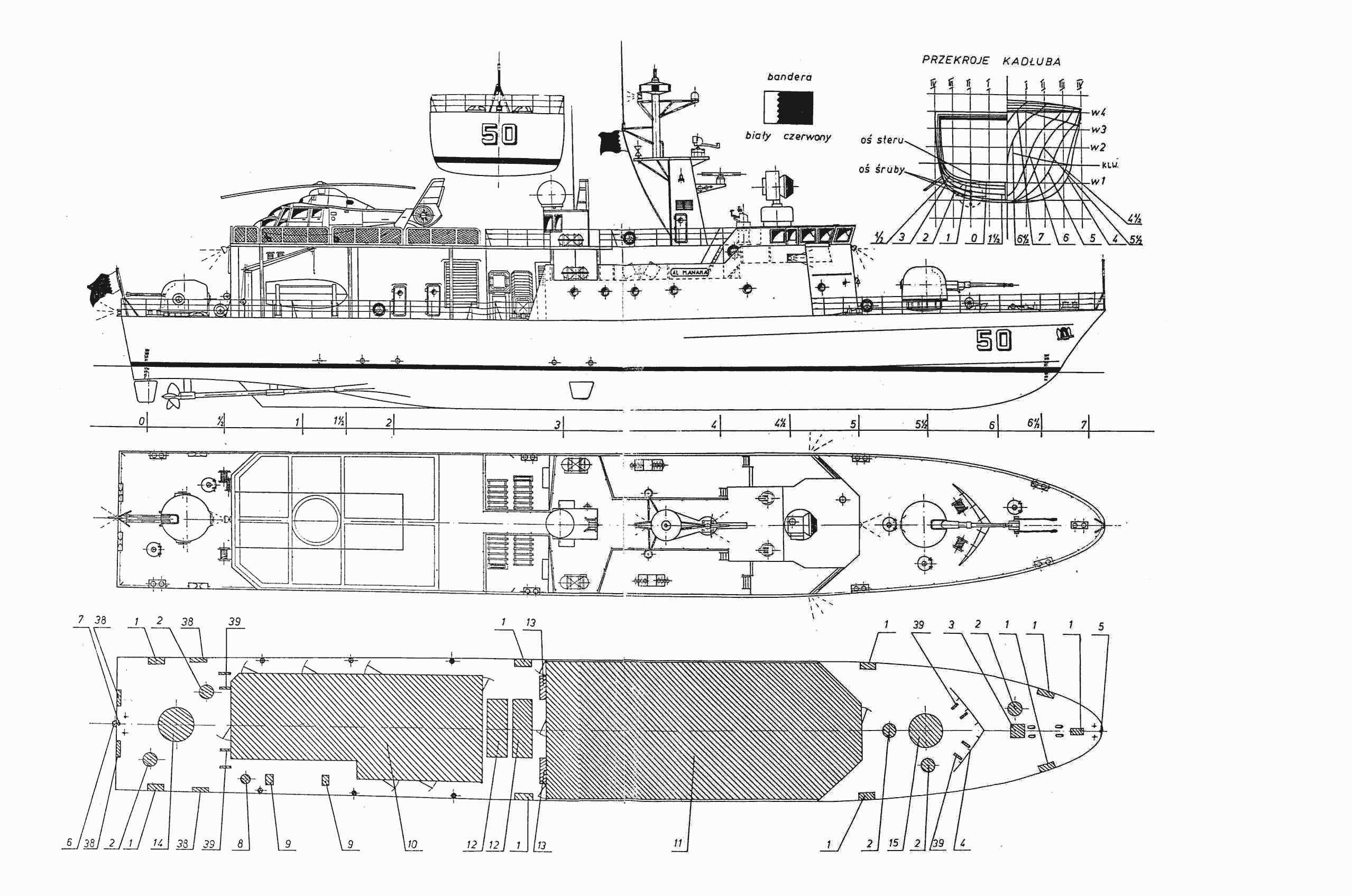
These are small, versatile missile corvettes capable of carrying a helicopter, ordered in February 1984. They were launched in 1986-87. The big after superstructure, topped with a landing platform, includes a helicopter hangar incorporating a lift. The Aerospatiale SA 365F Dauphin 2 helicopter is armed with AS 15TT SSM (all weather missiles tracked by radar rather than by a tail flare). Fitted with CSEE Panda Mk2 optical director. Magazine capacity is as follows: 400 rounds 76mm, 4400 rounds 40mm and 5000 rounds 20mm ammunition and eight AS 15TT SSM for helicopter launch. These corvettes can cruise at a continuous speed of 32kts with 16,000bhp engine MCR. They are much more capable than the standard fast attack craft and can serve as leaders for FAC squadrons providing over-horizon targeting for anti-ship missiles, using the embarked helicopter. Very similar ships serve in the navy of the United Arab Emirates.
Specs
536/632 t, 63 x 9.3 x 2.9m, 4 shafts MTU 20V538 TB92 diesels 18,740 bhp, 34.5 kts Range 4000 nm/16 kts. 4 MM40 Exocet SSM, 1x76mm OTO Melara, 2x 40mm Breda, 2x20mm Oerlikon GAM-BO1, CSEE Dagaie chaff RL, 1 helicopter. Radar PEAB Sea Giraffe, Racal Decca 1226, PEAB 9LV331, ESM/ECM Racal Decca Cutlass/Cygnus.
 Al-Riffa class FACs
Al-Riffa class FACs

2 ordered 1979, planned to have a 40 mm/70 Bofors and commissioned August-Nov. 1981.
Specs:
188/205t, 38.6 x 7 x 2.2m, 2 shafts MTU 20V 539 TB91 diesels 9500 bhp 34 kts. RA 550 nm/31 kts or 1100 nm/16 kts. Twin 40mm/70 Breda-Bofors Compatto, 2x20mm GAM 601 Oerlikon, mines, dagaie chaff RL, 5x50mm RFLon 40mm, 2×3 pdr saluting guns. Radar CSEE Lynx, Philips 9LV100G Philips 9GR600 Decca 1226.
 Ahmad El Fateh class FACs
Ahmad El Fateh class FACs

The first pair was ordered in Germany in 1979, second in May 1985 to a standard design. Launhed 1983-84 and 1986-88, close to models in UAE service. CSEE Panda optical director, carried 250 rds 40 mm, 6000 rds 7.62mm and can carry mines. Machinery reported to be capable of 15600 bhp and 41 kts
Specs
228/259t or 270t, 44.9/46.9 x 7/7.3 x 2.5/3m, 4 shafts MTU 16V538 TBI92 diesels 12.820 bhp nominal 40 kts. Range 1500 nm/15 kts, 500nm/38.5 kts.
Armed with 4 MM 40 Exocet SSM, 1x 76mm OTO Melara, 2×40/70 mm Breda, 3x LMGs. Radar PEAB LV223 Racad Decca 1226, ECM Racal Cygnus and ESM Decca RDLABC, Dagaie Chaff RL.
 Al Jarim class FACs
Al Jarim class FACs
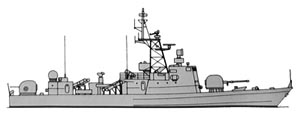
Tow fast attack fcrafts of aluminium contruction by Swiftships Morgan City in the USA, commissioned in February 1982 and extant.
Specs
33t, 1932 x 5.6 x 2m, 2 shafts Detroit 12V-71TVA diesels 1200 bjp 30 kts. 1x 20mm/93 Oerlikon GAM BO1, radar Decca 110
 Bangladesh Navy
Bangladesh Navy
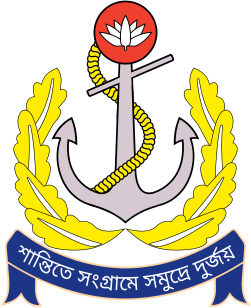 The Navy is one of the youngest worldwide. It was born not after the independence and partition of India in 1947, leading to three entities based on religion and geography: India proper, surrounded by West and East Pakistan (Bengal), the latter becoming independent in 1971. The Bangladesh’s 1971 liberation war against Pakistan was supported by India. The creation was sanctioned in July, but the country started with very little assets, the small “Eastern Pakistani fleet”. Official name is বাংলাদেশ নৌবাহিনী, “Bangladesh Nou Bahini”. Since Bangladesh is a Republic, Ships are simply prefixed BNS in English, standing for “Bangladesh Navy Ship”.
The Navy is one of the youngest worldwide. It was born not after the independence and partition of India in 1947, leading to three entities based on religion and geography: India proper, surrounded by West and East Pakistan (Bengal), the latter becoming independent in 1971. The Bangladesh’s 1971 liberation war against Pakistan was supported by India. The creation was sanctioned in July, but the country started with very little assets, the small “Eastern Pakistani fleet”. Official name is বাংলাদেশ নৌবাহিনী, “Bangladesh Nou Bahini”. Since Bangladesh is a Republic, Ships are simply prefixed BNS in English, standing for “Bangladesh Navy Ship”.
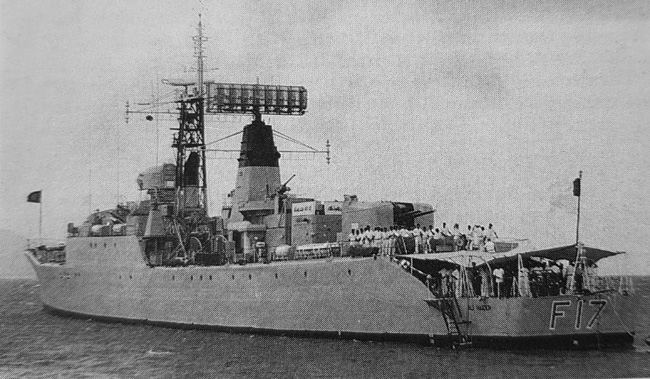
BNS Ali Haider in 1990, en Ex-British Leopard class Frigate Type 41 acquired in 1978. Her sister BNS Abu Bakr was acquired in 1982 (conways).
Birth in 1971: Existing assets
The People’s Republic of Bangladesh was proclaimed in what had been East Pakistan in April 1971. This was followed first by civil war and then in December by the Third Indo-Pakistan War, which resulted in the complete independence of Bangladesh. Although four Soviet ‘Vanya’ class minesweepers operated during 1972-74 in Bangladesh coastal waters to clear Chittagong of mines and wrecks these were not incorporated in the Bangladesh Navy, but returned to the USSR. The navy came into being with its own niver craft in 1972, and was formed around four old British fngates and a number. of transferred gunboats. There was also a small force of river gunboats.
On 9 November 1971 was created the first naval fleet (six small patrol vessels) which raided the Pakistani fleet, until mistakenly hit and sunk by the Indian Air Force on 10 December 1971. There was also a major raid on Mongla seaport. Postwar, it was assessed through various sources and report that the young navy had 334 sailors in service, and 22 KiA.
In all, some 45 operations were led, and between naval raids, many unconventional commando operations and general guerrilla style land/coastal/riverine warfare. The Navy was bolstered at first by defecting Bengali sailors, notably eight from Pakistan Navy submarine PNS Mangro under construction in France at the time. Well experiences and motiovated they created the core of the future navy, formed officers and manage to recruit more naval personnel until enough were able to wage war over 11 sectors, each with its own Commander with above Sector 10 for the whole coastal area, which in time supervised the orthers.
Ports and harbours needed to be guarded againt any reprisals by the Pakistani later, and sea lines of communication kept open. On the other hand the main objectove was soon for the for the bengalu themselves to prey on Pakistani sea lanes, and communication, fighting also against Pakistani river ports, seaports. Operation Jackpot became the largest and most successful of all as they manage to mine the Pasur River Channel and raiding the Pakistan Army by progressing inland. The embryonic Navy was late recoignised as a major player in the war of independence.
Postwar, the small initial naval staff relized soon that additional naval infrastructure was required, in addition to the one at Dakha reserved for the initial Bengal Fleet. A major addition were two ex-Royal Navy frigates (BNS Umar Farooq and BNS Ali Haider) in 1976-1978 completed in 1982 by BNS Abu Bakr, the meaty core of the Navy, which estended rather to the bottom, with a growingly larger fleet of smaller vessels, notably large patrol crafts.
Bases & Organization
Bases are Chittagong (HQ), Dhaka, Khulna, Juldia and Kaptai. According to the 2030 Forces Goal plans, extensions of the Navy in the 2010s were accompanied by efforts crowned by the opening of a new base, BNS Sher-e-Bangla, at Rabanabad, Patuakhali, built as the largest naval base, with submarine berthing, aviation facilities. BNS Sheikh Hasina was a submarine base commissioned 19 March 2023 at Pekua and another base, BNS Sheikh Mujib, was commissioned in Khilkhet, Dhaka.
1990-2000s Extensions
Bangladesh lacked the money back in 1995 to acquire new ships except for river gunboats. This changed however gradually over the next decades, and the Navy grew exponentially, notably with now a sizeable frigate fleet and missile corvettes/FACs acquired in the 2000s, but no submarines, which could be its major conventional deterrent. That is until 2017 and the acquisition of two Ming class, Type 053G, the Nabajatra class. Volunteer personnel numbered approximately 7,600 back in 1993. Today it’s 25,081 active duty personnel assisted by 2,500 civilians.

The Nabajatra class, a Chinese version of the Soviet Romeo class.
Albeit small, the country managed to bolster the fleet (today considered a green water navy, regional), in order at least to protected the country’s 118,813 square kilometres (45,874 sq mi) of maritime territorial area, defend harbours, bases and economic zones of interest. The fishery industry is notably vital for the population, allowed by ideal conditions in the delta. But the navy recenty was and is still involved in disaster management, humanitarian missions abroad, counter terrorism and global peacekeeping.
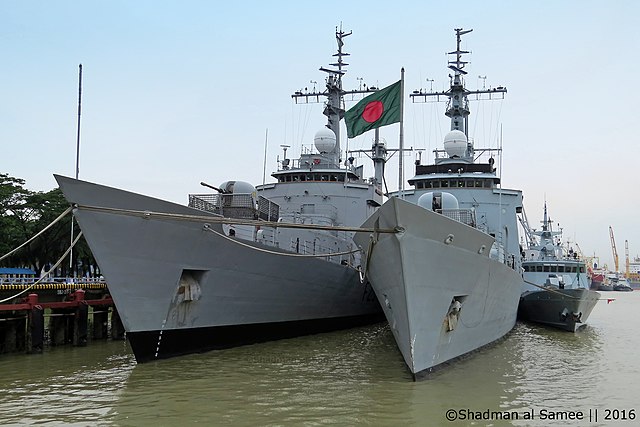
Significant dates and actions:
In 1993 the Bangladesh Navy was declared ready for UN Peacekeeping Operations the first by 2005, to Sudan as Force Riverine Unit (FRU). In 2010 it was deployed in Lebanon (UNIFIL) with BNS Osman and BNS Madhumati. In 2008 the Bangladesh–Myanmar naval standoff happened over disputed territory in the northeastern Bay of Bengal, both navies sortied in force and stood in cold confrontation, but the crisis (which started of course over discovered and untapped natural oil and gas reserves, ended after diplomatic negotiations. In 2012, these boundary disputes were solved at at an international tribunal.
Exercises
The Navy took also part in regular internatioal exercises such as CARAT with the USN since 2011, and the MILAN multinational naval exercise (Andaman Islands) from 2010, as well as AMAN, in the Arabian Sea, by the Pakistan Navy from 2009. Exercise Ferocious Falcon was a Crisis Management Exercise at Doha in Qatar by November 2012. Some ships also took part in naval exhibtions.
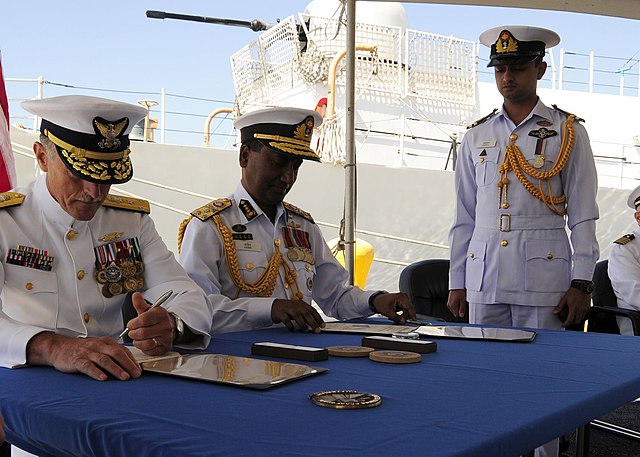
Relief efforts, humanitarian deployments:
In 2011, the Bangladesh Navy’s rescue and medical team and Bangladesh Army flew to Japan to assist the aftermath of the Tōhoku earthquake and tsunami. In 2013, BNS Somudra Joy landed humanitarian assistance and sent a medical team to the Philippines after another disaster.
The Bangladesh Navy also took part in the search for Malaysia Airlines Flight 370, renewed by May 2014 after debris were found in the Bay of Bengal. In 2014, the Water Crisis in Maldives saw BNS Somudra Joy arrving first, with 100 tonnes of bottled water…
The Bangladesh Navy in 1990
-Frigate Umar Farook (Salisbury class, acquired 1976)
-Ali Haider class (Leopard class frigates, acquired 1982)
-Osman (Jianghu II class frigate, acquired 1989)
-4 Duranta class FACs (Missiles) (Hoku class, acquired 1983)
-4 P4 class FACs (Torpedo) (Acquired 1983, discarded 1989)
-4 Durdarsha class FACs (Missiles) (Huangfeng class, Acquired 1988)
-4 Huchuan class FACs (Missile) transferred 1988 replacing the P4s.
-2 Karnapurli class Large Patrol Crafts (Kraljevica class, transferred 1975, BU 1988)
-2 Padma class Large Patrol Crafts (Akshay class, ex-India, transferred 1973-74)
-Bishkali (ex-PNS Jessore, sunk) Large Patrol Craft, salvaged, repaired, renamed 1971
-Shamjala: First dmestic large patrol craft built 1981-82.
-8 Shaheed class large patrol craft (Shanghai II type, transferred 1974-82)
-2 Durjoy class Large Patrol Crafts (Hainan class, transferred 1982-85)
-2 Meghna class CPCs (Singapore built, 410 tons, comm. 1986)
-5 Pabna class river patrol boats (1972-77, first Bangladesh, Dhaka-built warships)
-1 BNS Salam, Type 021-class gun boat comm. 1988, sunk 1991
-4 ex-Chinese Yuchuan Landing crafts, transferred 1986
-3 83t Bangladesh built landing crafts 1988
-1 BNFD Sundarban class Floating drydock, ex Yugoslavia, acquired 1980, extant
The Bangladesh Navy today: Modern assets
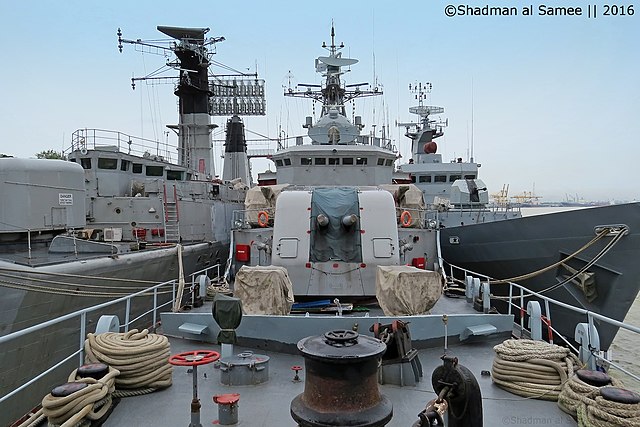
The prow of BNS Bijoy, Large Patrol Craft (cc)
-1 Frigate BNS Bangabandhu (Uslan class, S Korean built, comm. 2001)
-2 BNS Umar Farooq class frigates (Type 053H3 Jiangwei II class, comm. 2020)
-2 BNS Abu Bakr class frigates (Type 053H2 Jianghu-III class, comm. 2014)
-2 BNS Somudra Joy coast guard frigates (ex US Hamilton class High endurance cutter, comm. 2013)
-4 BNS Shadhinota class corvettes (Type 056 Shadhinota class, chinese built, comm. 2016)
-2 BNS Bijoy class corvettes (Castle class, improved, acquired 2011)
-5 BNS Sangu class patrol vessel (Island class, comm. 2004)
-4 Durjoy class LPC (see above, 2 more built locally, extant)
-BNS Madhumati, Korean built Sea Dragon class LPC, comm. 1998
-9 Padma class CPCs (see above, extant)
-2 Meghna class CPCs (see above, extant)
-Padna class CPC in construction from 2019 at Khulna Shipyard.
-4 Durdharsha class FACs (Type 021-class missile boat, see above, extant)
-1 BNS Barkat, Haizhui-class submarine chaser, comm. 1996, replacing BNS Salam, lost 1991.
-4 BNS Titash class SK built Chamsuri class Patrol crafts/gunboats comm. 2000-2004
-1 BNS Sagar, type 010 minehunter, comm. 1995
-4 Saikat class Minesweepers (Brit. conv. River class, transferred 1994)
-6 LCM-6s, ex-US, transferred 1992
-4 LCU BNS Dolphin class, locally built, delivered 2023
-2 BNS Swandwip class LCs, locally built 2015
-2 BNS Shah Poran class ex US LCUs 1992
-1 BNS Shah Amanat class ex Danish LCU 1990
-4 BNS LCM 101, Yuch’in or Yuchuan class LCMs 1986, extant (see above)
-2 BN LCT 103 class, Locally built 2015
-3 L1011 class LVCPs by Khulna Shipyard.
-8 X12 Fast patrol craft, Indonesian design, in construction
-6 US built Metal Shark Boats
-16 Defender-class boat
-6 research vessels: BNS Anushandhan (Roebuck), 2 Darshak class, BNS Agradoot, 2 Jarip boats.
-2 Resplenishment ships, Khan Jahan Ali, Imam Ghazzali
-3 Fleet/Harbour tenders
-1 BNS Shah Jalal diving support tender
-8 fleet Tugboats, 1 Sahayak class Repair ship, 1 Balaban class floating crane
Bangladesh Coast Guard:
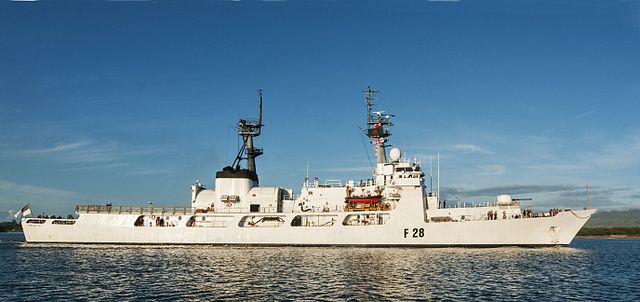
BNS Somudro Joy (F-28) being commissioned for transfer to the Bangladesh Navy, Pearl Harbor 2013
Presentation to come
-4 CGS Syed Nazrul (PL 71) Leader class large cutters
-8 Sobuj Bangla class Inshore PVs
-1 CGS Ruposhi Bangla (P20)
-2 Kutubdia class and 2 CGS Shetgang class FPVs
-4 CGS Tawfique class retransferred from the Navy, Shanghai II type
-5 Pabna class PBs, same.
-6 Atrai class harbour patrol boats (HPBs)
-10 X-12 fast patrol craft
-7 Sea Horse class Riverine PVs
-17 Metal shark boat HSB (High Speed Boats)
-5 Defender-class boat HSB
-3 Sebatori class ambulance boats
-6 Typhoon boat HSB
-2 Stingray boat HSB
-8 Tornado boat HSB
-19 Dolphin boat HSB
-3 Hurricane boat HSB
-23 Long range boats
-25 Rescue boats
In construction:
2 Inshore patrol vessel, 1 Self-propelled floating crane (BCGFC Shakti) 2 turgboats (BCGT Protay class); 4 Flat deck pontoons, 6 High speed boat (unnamed)
Plans for 2030 and beyond
By 2009, the government adopted the long-term modernisation plan “Forces Goal 2030” with a third of military hardware procured. It started with two refurbished Type 053H2 (Jianghu III) frigates in 2014, two ex-US Coast Guard High Endurance Cutters in 2015, and ex-RN survey vessel, two ex-Royal Navy Castle-class OPVs converted to guided missile corvettes in 2011 but also two Type 056 corvettes in 2016, two more ordered in July 2015, Two Durjoy-class LPCs by 2013, two more with extra ASW in 2017, 5 Padma-class OPVs in 2013 as well as many locally built LCUs/LCTs riverine and coastal patrol vessels.
Bengali Naval Aviation is born on 14 July 2011 with a few Agusta-Westland AW109 helicopters purchased, then two 228NG MPA in 2013. But the greatest leap forward in deterrence capabilities was the acquisition of its first two submarine, off-the-shelf, the Type 035G (Ming class) by March 2017.
Sources:
navy.mil.bd
en.wikipedia.org/ Bangladesh Navy ships
 Bolivian Navy
Bolivian Navy
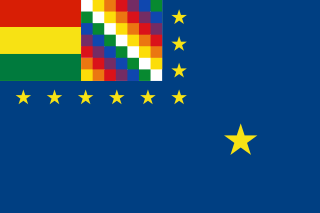
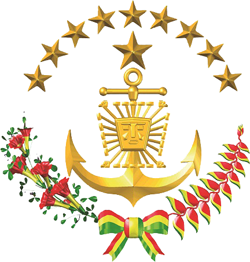 The Bolivian Navy (Armada Boliviana) emerged not at first from the independence in 1825, but rather from the 1866 Boundary Treaty signed between Chile and Bolivia to ensure a sea access to the country. Bolivia created a small fleet to take part in the War of the Pacific (1879–1883) but was defeated by Chile allongside Peru so the Bolivian coastline was retaken. However recovering this became a matter of honor and it had ramifications up to the present day’s Bolivian politics and trade.
The Bolivian Navy (Armada Boliviana) emerged not at first from the independence in 1825, but rather from the 1866 Boundary Treaty signed between Chile and Bolivia to ensure a sea access to the country. Bolivia created a small fleet to take part in the War of the Pacific (1879–1883) but was defeated by Chile allongside Peru so the Bolivian coastline was retaken. However recovering this became a matter of honor and it had ramifications up to the present day’s Bolivian politics and trade.
Nevertheless, the largely mountainous contry still maintains a navy on the Lake Titicaca plus its 5,000 miles of navigable rivers. There is no shortage of patrols to intercept smugglers, or supplying remote rural areas as a public service, rescuing people and livestock as floods happenes, and its personal today trains with the Argentine Navy, which included deployment under UN in Haiti.
The 1960s dispute with Chile abou the Rio Lanca and Pacific access did not prevented the creations in January 1963 of the River and Lake Force (Fuerza Fluvial y Lacustre) under the MoD, starting with just four US boats, 1,800 personnel from the Bolivian Army. A “furstrated brown navy” it became the “Bolivian Naval Force” (Fuerza Naval Boliviana) in January 1966 and then “Bolivian Navy” (Armada Boliviana) separated from the armed forces. There were 2600 personal in 1982, 5000 in 1992 and about the same today, 173 vessels all based on Lake Titicaca.
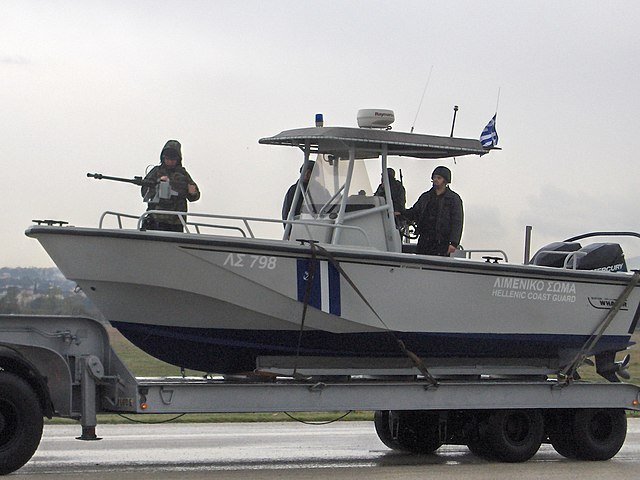
The Boston Whaler LP fast patrol boat (here from the Hellenic Navy) is the most common Bolivian riverine patroller.
From there, they patrols tributaries to the Amazon and take part in preventing drug trafficking across frontiers, while Lake Titicaca, shares a border with Peru. In 2010, Peru offered a 99 years concession with dock facilities, free-trade zone; leaving the possibility to Bolivia to have an annex for the Bolivian navy school on the Pacific.
Bases
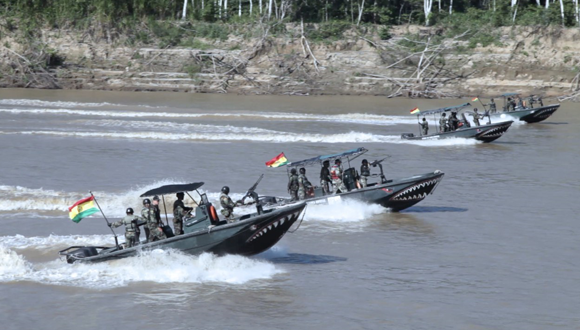
Bolivian PBs credits armada.mil.bo
The network was created to cover all major Bolivian inland waterways, didvided into Naval Districts:
DN1 Naval District “BENI”
DN2 Naval District “MAMORA”
DN3 Naval District “MADERA”
DN4 Naval District “TITICACA”
DN5 Naval District “SANTA CRUZ DE LA SIERRA”
DN6 Naval District “COBIJA”
AN 1 (naval service base) “COCHABAMBA”
AN 2 “SANTA CRUZ”
AN 3 “BERMEJO”
AN 4 “LA PAZ”
Special Operatio: TF “Blue Devils” (“Diablos Azules”), SINDA (Naval Intel Service), Immediate Response Group GRIN, High Altitude Diving Training Center and Command Training Center Amphibians
Bolivian Marines
The FNB Marine was created following the establishment of the Marine Battalion Almirante Grau in 1982, 600 men based on Tiquina Naval Base, Lake Titicaca. Later it became Marine Battalion Independence at Chua Cocani and this force includes paramilitaries. Seven naval infantry battalions were created over the years:
1st District “BENI”: I Marine Battalion “Bagué”
2nd District “MAMORA”: II Marine Battalion “Tocopilla”
3rd District “MADERA”: III Marine Battalion “Mejillones”
DN4 Titicaca: IV Marine Battalion “Alianza”, 6th Mechanized Marine Battalion “Independence”
DN5 “SANTA CRUZ DE LA SIERRA”: V Marine Battalion Calama
DN6 “COBIJA”: VII Marine Battalion “Columna Porvenir” and National Marine Security Corps
Bolivian Riverine Police
The Policía Militar Naval (PMN) mirrors the Military Police, tasked of Important Persons Protection, Physical Security, Patrol Facilities, Signals or naval protocol. These units are situated at AN 4 “La Paz” with 1st Naval Police Battalion, AN 1 “COCHABAMBA” with 2nd Naval Police Battalion “Quiver”, AN 2 “SANTA CRUZ” for the 3rd Naval Police Battalion, while DN4 Titicaca hosts the 4th Naval Police Battalion. In addition there are MP companies in the Naval Districts main bases.
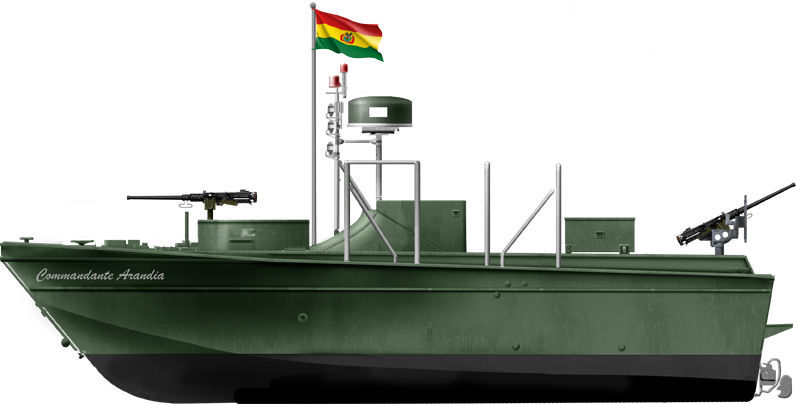
Author’s rendition of the Comandante Araudia
Assets
To patrol 12,000 miles, the Bolivian Navy acquired the 9000 grt Libertador Bolivar since 1977 as transport. In 1995 there were 30 riverine patrol crafts in operations, including 24 on Lake Titicaca, with two ex-US PBR mark 2. As of today, it operates the ex-US PR-51, Santa Cruz de la Sierra Class, 6 Capitan Bretel (Chinese Type 928 YC) class crafts, 4 Lake Class and 38 Boston Whaler Piranha LP, also ex-US. but also 8 Boston Whaler Piranha LP riverine assault boats Mk.1.
For various services, and locally built are three Servicio Industrial de la Marina (SIMA) Riverine hospital ships and a 226 ton PIASS Itinerant platform, 2 Hydrocarbon transporters, 2 Tankers, one transport and the TS Libertador Bolivar seen above, a masted barque and a single 55 feet Hatteras patrol vessel. It also had a sole Cessna 402 acquired in 2011 for air patrols.
Src
armada.mil.bo/
observers.france24.com/ Bolivia landlocked sea navy
wired.com/ bolivian-navy/
nytimes.com bolivia.html
news.com.au
en.wikipedia.org/
warisboring.com
warblogging.com riverboats used warfare today/
theguardian.com/
mindefbolivia
 Cambodian Navy
Cambodian Navy
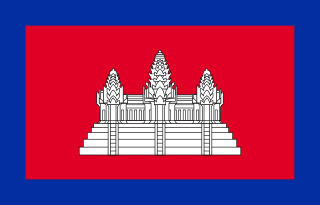 The Royal Cambodian Navy (កងទ័ពជើងទឹក ”Naval Army”) is part of Royal Cambodian Armed Forces under MoD direction and estimated 4,000 active personnel today, with a fleet of 228 boats/ships active under command of Admiral Tea Vinh. It started as the Khmer National Navy, originally an extension of the Khmer Royal Army, but it became separate in 1954. This was a pure “green navy”, performing coastal & riverine patrols and using internal waterways for internal security. In 1967 it reached a total of 1,400, with 200 as Naval Infantry.
The Royal Cambodian Navy (កងទ័ពជើងទឹក ”Naval Army”) is part of Royal Cambodian Armed Forces under MoD direction and estimated 4,000 active personnel today, with a fleet of 228 boats/ships active under command of Admiral Tea Vinh. It started as the Khmer National Navy, originally an extension of the Khmer Royal Army, but it became separate in 1954. This was a pure “green navy”, performing coastal & riverine patrols and using internal waterways for internal security. In 1967 it reached a total of 1,400, with 200 as Naval Infantry.
For context, the ancient and once Imperial, later Khmer Kingdom, is bordered by Thailand (northwest), Laos (north), Vietnam (east) with a maritime façade as the Gulf of Thailand (southwest), capital Phnom Penh. When the country was an Empire directed from the capital Angkor (802 AD), its fleet grew accoprdingly, although we have little informations about ther types used, mostly riverine types, catamaran-like and rowed. It was Southeast Asia’s largest empire in the 12th century but declined in a series of wars with neighbours, and fell eventually to the Ayutthaya Kingdom while the capital was abandoned in 1432. In 1863, the country fell to French colonization, a protectorate with the installed king Norodom. As the French feared a contagion of insurgency as war raged in neighbouring Indochina (Vietnam-Laos-Thailand), the country was gained full independence in 1953, after 90 years of foreign domination, seeing the creation of the Navy as well as the other armed forces.
In the cold war
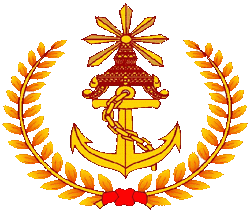 Cambodia (now known as Kampuchea) became a French protectorate in 1867 and a French colony in 1887. She became an independent kingdom within the French Union in 1949 and became truly independent in 1954. The Marine Royal Khmer was set up on 20 April 1954 with French assistance. The Vietcong made use of eastern Cambodia and Prince Norodom Sihanouk tried to steer a neutral course. This meant that the navy received very few ships from abroad and the country lacked the money or inclination to purchase any.
Cambodia (now known as Kampuchea) became a French protectorate in 1867 and a French colony in 1887. She became an independent kingdom within the French Union in 1949 and became truly independent in 1954. The Marine Royal Khmer was set up on 20 April 1954 with French assistance. The Vietcong made use of eastern Cambodia and Prince Norodom Sihanouk tried to steer a neutral course. This meant that the navy received very few ships from abroad and the country lacked the money or inclination to purchase any.
There were border incidents in the late 1960s with Thailand and South Vietnam and in May 1970 the Americans and South Vietnamese invaded East Cambodia to eradicate the Vietcong. Sihanouk was overthrown and a pro-Western military government took over, renaming the navy, Marine National Khmer. American aid was lavished on the armed forces, including the navy, but the indigenous Khmer Rouge pushed them back and besieged the capital, Phnom Penh, from 1973 until, the river lifeline cut, it surrendered in April 1975. At that juncture the navy totalled 11,000 men including 4000 marines, all 18-month conscripts.
Most of the major warships fled to Thailand or the Philippines, two MTBs were sunk during the American operations to recapture the freighter Mayaguez, and most of the remaining ships were sunk or discarded during the Khmer Rouge dictatorship or the subsequent Vietnamese invasion. The continuing three-way civil war has retarded the country’s recovery and the navy relies on vessels transferred trom the USSR in the mid-1980s.
Ex-French EDIC type landing craft
French LST 606, built by Franco-Belge in 1968 69, was transferred to Cambodia on completion in August 1969, and renumbered T 916. She was discarded in 1979.
Ex-US landing crafts:
Two ex-USN LCT 6, transferred to France in 1951 for service in Indo-China, were transferred by the French to Cambodia in 1956 57. They were deleted in c1973 75, Two ex-USN LCU 501 Type were transferred first to France then to Cambodia at about the same time. Two more were transferred on 31 May 1962, and two more in November 1972. Four were deleted in 1979, An ex USN LCU 1466 Type was also transferred in October 1969, 7° 979 (ex-USN LCU 1577) was sunk by a mine on 5 May 1970. The remainder were either repossessed by the USN or deleted berween 1973 -75, In the carly 1970s twenty ex-USN LCM 6 and twenty-three exUSN ATC (converted LCM 6 or 8) were also transferred and suffered the same fate.
Ex-US PC class large patrol craft:
Two ex-USN PCs, transferred to the French Navy in 1951 for use in IndoChina, were transferred to the Cambodian Navy in 1955-56. They were E 311 (ex-Flamberge, ex-USS PC 1086), and E 312 (ex-L’Inconstant, ex-USS PC 1171). E 311 fled to Thailand on 16 May 1975 and has been scrapped. E 312 fled to the Philippines on 21 May 1975, and was incorporated into the Philippines Navy in December 1976 as Negros Onental.
Ex-Yugoslav Type 108 fast attack craft (torpedo):
Two were presented to Cambodia in 1965, and renumbered VR 1 and VR 2. Both sunk by US aircraft on 13 May 1975 during the Mayaguez incident.
Ex-US LSIL class landing craft (support gunboats):
-P 111 (ex-USS LSIL 9039, ex-LSIL 875) and P 112 (ex-Medecin Capitaine Le Gall, ex-USS LSIL unknown number) had been USN rearmed large infantry landing craft transferred to the French Navy in 1951 for service in Indo-China. The French transferred them to Cambodia in 1957. Both escaped to the Philippines on 17 Apil 1975, and P 111 was incorporated in the Philippines Navy on 17 November 1977 as Marindugque.
Ex-US patrol gunboat:
US PGM 70 was transferred to Cambodia under MDAP in 1964. She was deleted during 1973-75.
Ex-Soviet “TURYA I” class patrol craft:
Three delivered 1984-85 without torpedo tubes. Extant 1995.
Ex-Soviet “STENKA” class patrol craft:
Four delivered 1985 87, Two cannibalised for spares, remainder extant 1995.
Ex-Soviet “T 4” class landing craft:
Two transferred 1984-85, Both extant 1995.
Ex-British harbour defence motor launches (HDML):
Three RN HDMLs, among twenty-six transferred to the Free French Navy in 1943, were transferred by the French to Cambodia. VP 762 (ex-VP 42, ex-HDML 1457) was transferred in 1956; VP 748 (ex-HDML 1223) and VP 749 (ex-HDML 1229) followed a year later. VP 2/2 (ex-748) was the only one to survive the Khmer Rouge takeover. Stricken by 1995.
-Three ex-Chinese “Yulin” type coastal patrol boats: Transferred to Cambodia in January 1968 and renumbered VP 1, 2, 3. No longer in service in 1995.
-Two ex-USN AVR type, 17 ex-USN ‘Swift’ class PCF and 65 ex-USN PBR Mk I and Mk 2 river patrol craft were transferred to Cambodia in 1972-74. Several were sunk in 1973~75 and others reclaimed by the USN. Only two PBR reported extant 1995.
Strenght Today
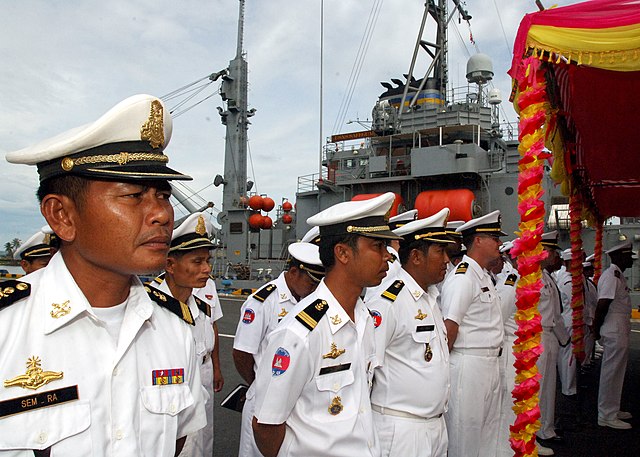
The navy possesses 15 patrol craft and 5 “fast attack” patrol craft plus about 200 motorised and manual canoes. For seagoing action in August 2005 China transferred 5 patrol boats. In 2007 a further 10 (worth $100,000,000) were added to this. They were donated by China to help counter piracy in the region as well as transnational crime, smuggling and for future Chinese oil installations. In 2007, Cambodia reported 3,000 sailors under the flag and a force of 2,000 Marine infantry.
The lack of infrastructure is however a problem: Many officers of the Royal Cambodian Navy were trained, and continue to do so at the Vietnam Naval Academy.
There are current plans to increase the fleet’s strenght, with assistance from China, but also Germany, Vietnam, Indonesia, South Korea, and Japan.
Naval bases inclused the Headquarters located in Chroy Changvar and Ream Naval Base, with all installations and facilities, dokcyard and workshops for the patrol ships maintenance.
This is however a small regional green water navy still today, unable to “project power” beside its limited maritime EEZ, and without any missile-armed sea-going vessel.
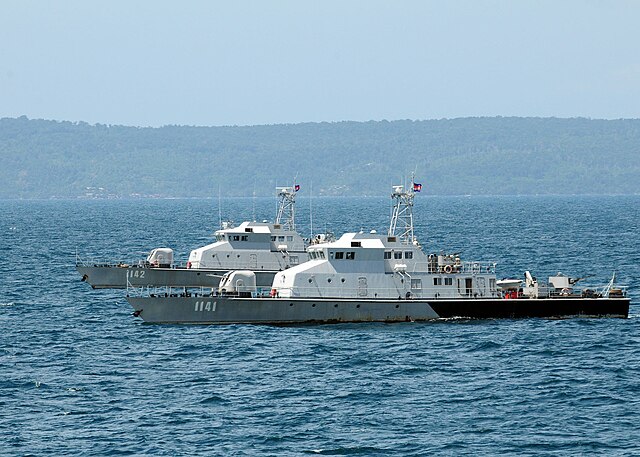
HQ Chroy Changvar:
-3x ASPB: pennants #2903, 2904, 2905, Inherited from the KPRN.
-3x Koh Kong-class (Koh Kong, Koh Sdach, Koh Ampil) #2101 2102 2103 Albatroz-class acquired in 2015.
-2x Large Patrol Craft Turya-class Project 206M #1121 #1122 inherited from the KPRN. Decomm. 2015.
-2x Small Landing Craft LCM-6 type (#2402 2406) Inherited from the KPRN, status unknown.
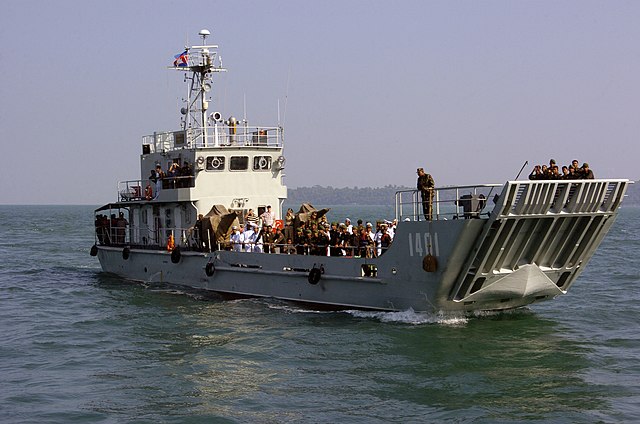
Ream Naval Base:
-2x Koh Yor-class Project 1400ME Russ. Zhuk class (Koh Yor, Koh Tunsay #1101 1102) inherited from the KPRN. In 1975 three units had been transferred from the Soviet Union. In 1988 a fourth was returned by Vietnam. Used for riverine patrol, they are active.
-2x Koh Pothi-class Swift-class Mk. III (Koh Pothi, Koh Seh #1103 1104) inherited from the KPRN, Khmer Rouge, captured from the US and Khmer Navy.
-2x Koh Chhlam-class FPB 21-class (Koh Chhlam, Koh Rong #1105 1106) acquired by the RCN in 1997.
-3x Koh Ruesay-class (Koh Ruesay, Koh Py, Koh Krabey #1107 1108 1109) donated by China.
-2x Shershen-class Large Patrol Craft Project 206-class (#1123 1124) donated by Vietnam, TT removed as DC racks. 1 ex-Vietnamese, one ex-USSR donated by Vietnam in 1998. Due to refurbishment before transfer, more active units in the Cambodian navy. Decommissioned 2015.
-4x Koh Polowai-class Project 02059 (Koh Polowai, Koh Tang, Koh Pring, Koh Via #1131 1132 1133 1134) inherited from the KPRN. 5 boats transferred 1985–1987. Rearmed with twin 40mm Bofors L/60 guns forward and ZU-23-2 aft, replacing the AK-230 turrets. Torpedo tubes removed.
-4x Koh Svay-class (Koh Svay, Koh Kras, Koh Krasar, Koh Tbal #1141 1142 1143 1144) donated by China.
-1x Yuch’in-class Type 069 Large Landing Craft #1401 donated by China*.
-1x LCM-8 Inherited from the KPRN. Unknown pennant, likely in reserve.
*Specs Type 069: 86 tonnes FL, Dimensions 24.8 x 5.2 x 1.3 m, 2 x Type 12V 150C diesels 600 hp (450 kW) 11.5 knots RA 450 nm, 150 troops, crew 12 armed with 2×2 14.5 mm HMG.
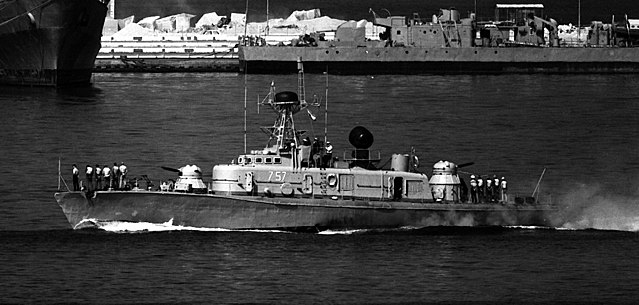
A Shershen class boat. They were among the best Cambodian coastal vessels in the cold war.
Refs
navy.mil.kh/ Official
Khmer National Navy
en.wikipedia.org Royal_Cambodian_Navy
globalsecurity.org
on navypedia.org/
The Royal Cambodian Navy ByJames Goldrick, Jack McCaffrie
edition.cnn.com 2023/ cambodia ream naval base analysis
What’s Happening At Cambodia’s Ream Naval Base?
Breaking down Cambodia’s naval base controversy
US, Royal Cambodian Forces Combine for Cooperation Afloat Readiness and Training Cambodia 2016state.gov Public Designation of Cambodian Officials Due to Involvement in Significant Corruption
phnompenhpost.com/ japanese navy plans sihanoukville stop
MONDOLKIRI patrol craft (1985-1987)
1107 patrol boats (2007)
KAOH CHHLAM patrol boats (1997)
P121 patrol boats (1972-1973)
41 patrol boats (1985-1988)
2101 patrol boats (2015)
VP1 coastal patrol boats (1964-1968/1968)
1141 patrol craft (2007)
1401 landing craft (1970s/2007)
 Comoros Navy
Comoros Navy
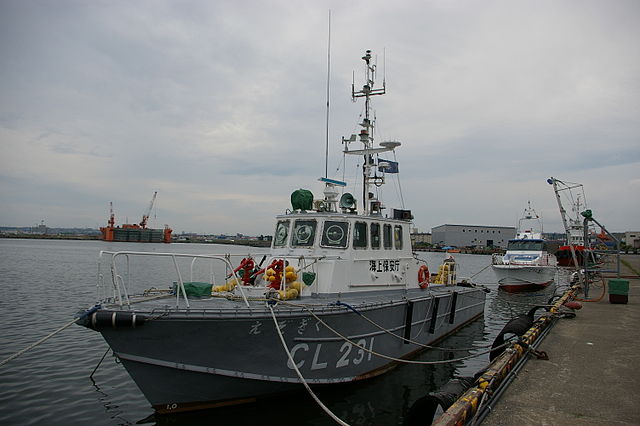
A Yamayuri class patrol craft
There is no “navy” of the Comoros per se, but a small coast guard force. Comoros are Indian Ocean islands, located off the southeastern African coast, in between there and Madagascar’s northern tip. It was independent from France in 1975 and started to constitute its armed forces. The Comorian Armed Forces (“Armée nationale de développement”) consist of a small 500 strong standing army and 500 strong police forces. There is a defense treaty with France for protecting its territorial waters and training Comorian military personnel as well as ensuring air surveillance. France also maintains a small troop presence there at government request and small Naval base plus its Foreign Legion Detachment (DLEM), in Mayotte island.
One recent aspect is massive immigration from Africa and the problems with local population at Mayotte. There is no such problem with Comoros, whereas Mayotte choosed to stay with France (as DOM-TOM) or “ovesea territory” and thus, offering de facto EU citizenship. This had toned down the revendication of Comoros over Mayotte. It should be added that Azali Assoumani, President of the Comoros and Chair of the African Union made a strong rapprochement with Russian President Vladimir Putin recently.
Comorian Coast Guard (2010)
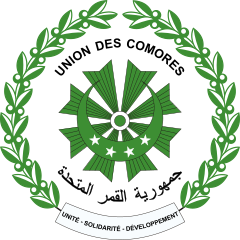 France provides the bulk of Comoros naval assets by its own means. Still was transferred in 1976 the former LCT 9061 to carry troops, hardware and civilian personal between islands, which was the former RN WW2 HMS Butrress, LCT(8) 4099. It’s probably retired now. Two Japanese Maritime Safety Agency vessels of the Yamayuri class were transferred in October 1981 as patrol boats Kasthala and Ntringhuin still active today.
France provides the bulk of Comoros naval assets by its own means. Still was transferred in 1976 the former LCT 9061 to carry troops, hardware and civilian personal between islands, which was the former RN WW2 HMS Butrress, LCT(8) 4099. It’s probably retired now. Two Japanese Maritime Safety Agency vessels of the Yamayuri class were transferred in October 1981 as patrol boats Kasthala and Ntringhuin still active today.
Due to the lack of a national navy, converted civilian boats were used in the 2008 operation against Mohamed Bacar, president of Anjouan. 2 supply ships are chartered by the army. A third, the coaster Taurus, was destroyed in a fire on the night of Saturday March 2008.
The two Yamayuri type patrol boats displaces 27 tonnes for 18 meters long. They are armed with 2 Browning M2HB 12.7 mm machine guns. Current status unknown.
There is a single gendarmerie boat, Barracuda inflatable type.
The former British landing craft tank (1943) displaced 657t for 70.48 m long, 11.90 m wide was withdrawn from service before 2000.
On January 2, 2010, the Comorian president announced the creation of the Coast Guard as an independent branch.
The associated aviation is managed by the air force, there is no naval air service. It consists of a single Cessna 402 for transport, the presidential L-410 Turbolet, one Aérospatiale Corvette as VIP transport, two Mil Mi-14PZh, one Eurocopter AS350 Écureuil and five SIAI-Marchetti SF.260 trainers and patrollers.
Src
Conway’s all the world’s fighting ships 1947-95, page 70.
en.wikipedia.org Army of National Development
 Costa Rica Coast Guard
Costa Rica Coast Guard
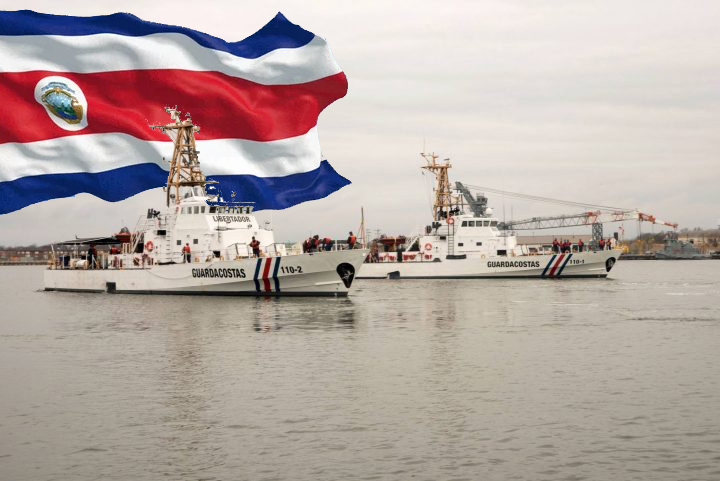
Another very small “navy”, Costa Rica is in reality a coast guard, or brown water navy called the Guardia Civil. This is a gendarmerie force for limited national defense and internal security, riverine. It is however the largest branch of the Fuerza Pública and perhaps the best equipped and trained with between 15,000 and 10,000 Civil Guards and in the 1990s some 27,000 active troops
The Civil Guard was founded in 1949, combining all three service branches (army, air force, navy) as well as the national police and coast guard and although having a limited military capacity its primary role is and remains internal security. It started with 10,000 until the mid-1970s and then rose to 45,000, taking gradually more military roles.
Costa Rica Guardia Civil in the cold war
The Civil Guard was gthered in seven provincial companies with about 40% stationed at the capital of San José. There was an attempted invasion from Nicaragua in 1955 which urged the need of a sufficient deterrence and albeit the abolition of its military between 1950 and 1970 Costa Rica was paid 1.8 million USD in military aid then 113,000 USD in surplus equipment to maintain its integrity and allow US training in its waters and help any intrusion towards strategically important Panama Canal.
The Civil Guard Coast Guard from 1949 had a single 90-foot launch for both coasts, Carribean and Pacific, and a rescue tug on the Caribbean, three small boats for general purposes arrived in the mid-1950s and in 1980 six launches (100 ton, five of 36 tons).
Organization: Seven batallion size were created at Alajuela, Cartago, Guanacaste, Heredia, Limón, Puntarenas and San José plus the Presidential Guard, Northern Border Security Battalion, a COIN or Counterinsurgency Battalion and the Special Intervention Unit (Unidad Especial de Intervención) in the mid-1980s and is between 60 and 80 men strong.
The main naval operating base is Limón on the Carribean coast. On the Pacific, Potrero, Coco, Panama, Purto Castilla, Puerto Soley in Guanacaste Province and well-placed and covered Golfito on the Puntarenas province. However infrastructures are under-developed to sustain a larger fleet and the economy is largely dependent on tourism.
In total with these meagre assets, the force is supposed to patrol and police some 19,653 square miles of coastline, not countring rivers, such as the Rio Chico and Rio Chiquito Nuevo, the latter being a large and important waterway for internal transport coast to coast.
According to Conways 1995, page 71, the force had ten patrol crafts:
Although Costa Rica possesses both Pacific and Caribbean coastlines and covers an area of some 19,653 square miles, she has no military forces of any significance. The Civil Guard, numbering about 1200 men, 1s responsible along with a police force of some 3000 for internal security, the Army having been abolished in 1948. In an area of politcal upheaval and uncertainty (Costa Rica is bordered by Nicaragua to the north and Panama to the south) the country remains stable and operates only ten patrol craft. These include a 105ft ‘Swift’ class fast patrol boat, five smaller 65ft ‘Swift’ class patrol boats, all six built in 1979 and three coastal patrol craft built in the mid-1950s (10t), one ex-USCG ‘Cape’ class craft and one ex-USCG ‘Point class craft. There are also two 36ft and one 42ft ‘Swift’ inshore patrol craft. Conways all the world’s fighting ships 1947-1995
Legacy: The torpedo boat Branilio Garillo Built at Yarrow, Poplar in 1890 and similar to TB50. 15t, 18.3 x 2.82 x 1.07m, 1 VTE, 1 loco boiler 230 shp, 17 kts, 47mm/40 Hotchkiss gun and single bow TT 356mm TT. Discarded in 1920, likely preserved.
-NO401 patrol launches (1950s): 401-403, 40ft type 10m patrol boats, stricken early 1980s
-ISLA DEL COCO patrol boat (1978): 118t OPV built at Swiftships, Morgan City as 105ft Commercial Cruiser class, 3 MGs, 1 mortar.
-CABO VELAS patrol boats (1978-1979): SP656-59 Cabo Velasn Isla Uvita, Cabo Blanco, Punta Burica, Swiftships 65ft Commercial Cruiser class, same.
-PUNTARENA patrol launch (1986): Renamed Donna Margarita and Primera Dama, from Swiftships, Morgan Cityn 42ft design, same as above.
-TELAMANCA patrol launches (1986): SP361 Telamanca (later Puerto Quepos), Cariari, Swiftships US 36ft design in Aluminium, 1 cal.50, 1 cal.30 plus mortar.
-ASTRONAUTA FRANKLIN CHANG patrol boat (1958/1989): Former USCG Yard Curtis Bay SP951 cutter, Cape-class.
Costa Rica Guardia Civil today
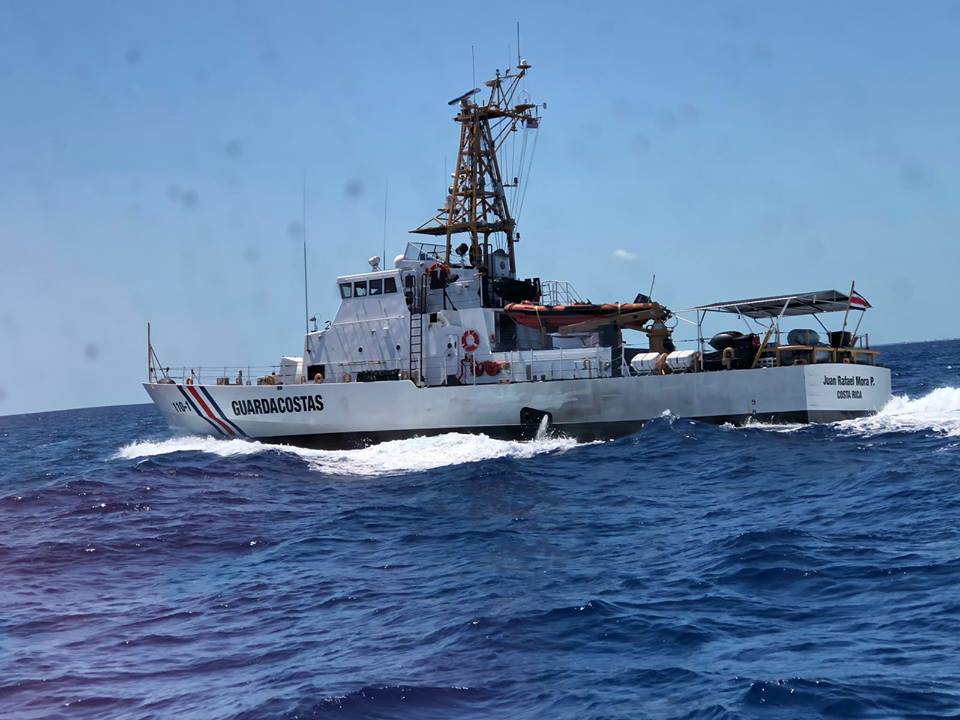
Libertador Juan Rafael Mora Poras
In 1996, the Ministry of Public Security was established to controlling the Fuerza Pública, reorganized to replace the Civil Guard, Rural Assistance Guard and Frontier Guards, this new single corps under the MoD with a geographic command basis including counter-narcotics and border patrol. It seems only 250 personal strong today with civilian harbours and a few yards.
The Coastguard only had few patrol boats to police rivers and two coasts, but in case it could be reinforced by reservists with a global pool of some 10,000 and operate requisitions.
Coast Guard, Caribbean coast:
-1 large patrol boat
-5 small patrol boats
-1 rescue Tug
Coast Guard, Pacific coast:
-3 small patrol launches
COLONEL ALFONSO MONGE patrol boats (Built 1991-2001): Col. A. Monge, Santa Maria, Juan Rafael Mora, Pancha Carrasco, ex USCG Point-class cutters, 2 discarded 2002.
JUAN RAFAEL MORA PORAS patrol boats (Built at Bollinger, Lockport 1991-1992): J. R. Mora Poras, General Jose M. Canas, Rodrigo Carrazo, ex USCG USCG Island-class cutters.
Air section:
After the 1955 invasion, P-51 fighters donated by the US arrived but they were not used long and there was no dedicated air asset for naval purpose, rather it is mission-based with one Beech C-45, one Cessna 170, two Cessna 180’s and three Cessna U-17′ then three DHC-3 Otters and two Bell 47 helicopters acquired over time but no proper militar aircraft or helicopter until the 1970s acquisition of second-hand ex-US two Sikorsky S-58s, one FH-1100, two Hughes 269C’s and two Bell UH-1Bs and in 1980 the civilian park was augmented by a single Piper Seneca, two Piper Aztecs and three Piper Cherokees.
Sources
en.wikipedia.org/ Costa Rican Civil Guard
on laststandonzombieisland.com
on dialogo-americas.com/
on navypedia.org/
ticotimes.net/ us-donates 19 million to costa rica coast guard
news.co.cr patrol-ships donated costa rica sailed out from baltimore
airandsurface.com coast-guard-in-costa-rica/
navaltoday.com 2018 transfers
defensa.com
webinfomil.com/
nacion.com/
thecostaricanews.com/
 Croatian Navy
Croatian Navy
The Croatian Navy is abbreviated HRM standing for Hrvatska ratna mornarica, formed in 1991 from the former Yugoslav Navy after breakup of Yugoslavia and Croatian War of Independence. It operates today a force of 30 vessels between the Flotilla and Coast Guard for a total of 1,363 personal as of 2020. It is a green water navy and major Adriatic naval power but only possesses five missile boats and a dozen of shore-base missile launchers, not including mobile ones. The HQ is based in Split and its Patron is St Nicholas.
A sort history 1991-2024
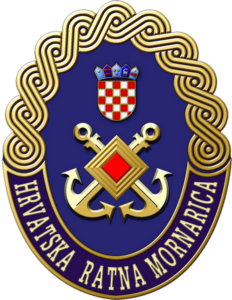 Historically, the navy existed already in the 9th century as part of the Duchy fleet, later a Kingdom, battling Independent City States and maintaining its control on the easter Adriatic coast and trade relations with Venice. In fact the first Croat naval victory dates back when duke Branimir defeated a Venetian expedition on September 18, 887 (now Croatian Navy Day). Relations were complicated to say the leas with the Serenissima, and relatiatory raids were led by duke Domagoj and king Petar Krešimir IV. There was a larger Royal Croatian-Dalmatian operating 12-15 galleys under Louis I in the 14th century. But ultimately Venice established control on the Croatian coast until 1797. The sailors operated afterwards withing the Austro-Hungarian Navy until 1918, and under the new established unified Yugoslav Navy from 1918 and until 1941 Italian and later German invasions. A Croatian Navy was re-established by the Germans in 1942 and operated with the axis until 1945, then was disbanded. The new Yugoslav Popular Republic under Tito re-established the Yugoslav Navy which was active until 1991.
Historically, the navy existed already in the 9th century as part of the Duchy fleet, later a Kingdom, battling Independent City States and maintaining its control on the easter Adriatic coast and trade relations with Venice. In fact the first Croat naval victory dates back when duke Branimir defeated a Venetian expedition on September 18, 887 (now Croatian Navy Day). Relations were complicated to say the leas with the Serenissima, and relatiatory raids were led by duke Domagoj and king Petar Krešimir IV. There was a larger Royal Croatian-Dalmatian operating 12-15 galleys under Louis I in the 14th century. But ultimately Venice established control on the Croatian coast until 1797. The sailors operated afterwards withing the Austro-Hungarian Navy until 1918, and under the new established unified Yugoslav Navy from 1918 and until 1941 Italian and later German invasions. A Croatian Navy was re-established by the Germans in 1942 and operated with the axis until 1945, then was disbanded. The new Yugoslav Popular Republic under Tito re-established the Yugoslav Navy which was active until 1991.
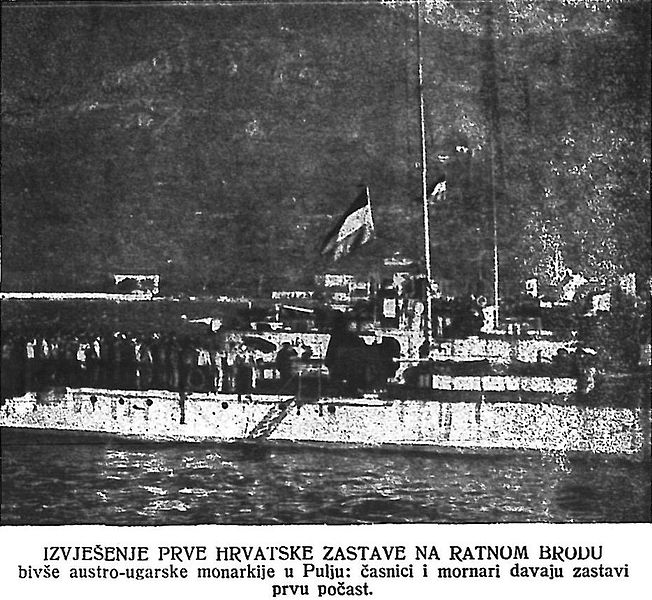
The only ship flying for a short time a Croatian flag in 1918 was in Pula with the “Pula”, on October 31st, 1918, with crews saluting the flag.
During the Austria-Hungarian era, it’s Croatia that control most of the Adriatic coast accessible to the Empire, and thus, its deputies had some leeway in the parliament. The large Royal Habsburg arsenal and naval shipyard were established in Kraljevica as far back as 1729 and over two centuties and until WW1 were developed naval bases, schools, shipyards, then a headquarter and naval academy in Pula and Rijeka respectively. Pula (Pola) became the main military fleet port for the Austro-Hungarian Navy –KuK Kriegsmarine– and its emblem included the Croatian coat of arms. Most officers came from Croatia such as the grand admiral Maximilian Njegovan. In the 1870s, it’s a Croatian officers that pioneered the torpedo, refined later by Robert Whitehead in its Croatian workshop. In 1885, 45% of sailors and lower officers were Croatians but the Empire retook control of the fleet and so only 10.3% of upper echelon as well as the naval staff were from Croatia and with the rapid expansion of the fleet, this went down to 30 and 10%. In addition to be barred from upper écheclons, Croats were often see as simple stokers and deck hands, set aside due to their ignorance of the German language.
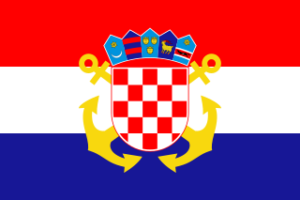
naval ensign of Croatia
By late October 1918, the Empire started to fall apart as war drew to its end, and to appease insurgency, emperor Charles handed the Navy over to the Zagreb People’s Council. Vuković became rear admiral and fleet commander and the new united State of Slovenes, Croats and Serb’s flag on 31 October 1918. It was raised on the bulk of the fleet, notably the flagship SMS Viribus Unitis causing Italy’s rage, as well as ship in Kotor until Entente navies promptly recaptured them all, later to be divided as war prizes. There was in fact an operation led against Viribus Unitis (“With United Forces”) before an agreement was made and the intact, powerful battleship (armed with nine 12-inches main guns) renamed “Jugoslavija” after being acquired on 31 October 1918 and sunk the following day on 1 November 1918 by Italian divers.
The newly formed Yugoslav Navy in 1920 was thus reduced to a few vessels.
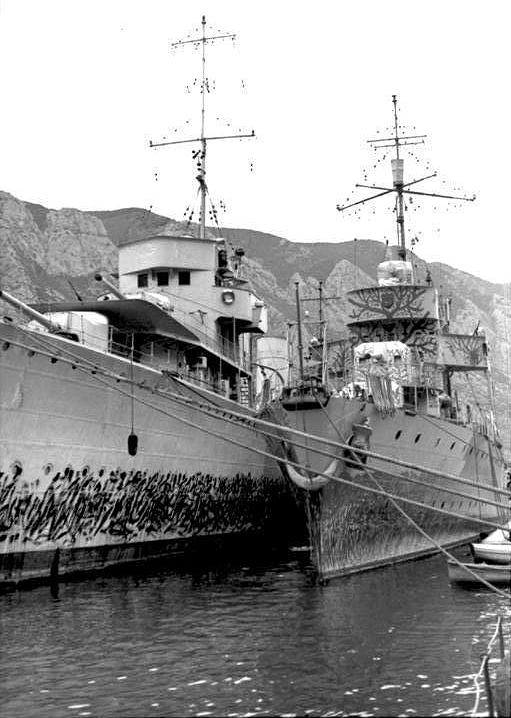
Croatian officers and sailors went on manning most of the ships of the new Royal Yugoslav Navy until WW2. They were a majorit for example in the flagship cruiser (Former Geman) Dalmacija and large destroyer Dubrovnik. The Axis invasion of Yugoslavia put an end to the Navy, which was captured and recommissioned by the Regia Marina. Meanwhile under occupation, Croatian partisans started a guerilla Navy with all sorts of captured vessels in 1942 against Italian and German forced along the shore, and a largest faction later started to cooperate closely with the Royal Navy. After the war, a new Socialist Yugoslav Navy was headquertered at Split with shipyards and arsenals in Šibenik, Split, Kraljevica, Rijeka and Pula.
Post-1991 Croatian Navy
The new Socialist Yugoslav Navy stayed independent and it showed in its procurement and composition, as the country never was part of the Warsaw Pact. The 1947 Navy was equipped with an amazing mix, an ex-Yugoslavian sub and Italian CB plus a Flutto class, a former Flower class corvette, pre-WWI torpedo boats and Orjen class or Higgins MTBs, ex talian and German minesweepers and landing crafts. Its flagship was again a destroyer, Split, this time built at home at Rijeka yard on French Plans and US weaponry and electronics… The Navy also acquired in 1956 two ex W class destroyers, obtained in 1980 two ex-Soviet Koni class frigates, and built its own Kotor class (two ships) and uniquely built three classes of submarines at home, the Sujetska (1959), Heroj (1967), Sava (1977) Una (1985) and lora (1990s) classes plus a number of “spec ops” midgets. This was its main adriatic deterrence. Local industries were capable of providing also the bulk of its coastal assets, wether they were FACs and large patrol crafts.
In 1990 the Croatians decided to establish their independent state, for the second time in the twentieth century. Despite Serbian opposition (both political and military) independence was declared in July 1991, but was acknowledged by most European states only six months later, The Croatian Navy was established in September 1991 and onc of its main tasks was to secure the coastline, as almost all former Yugoslavian coast and naval bases (such as Split, Sibenik, Pola and Ploce) were on Croatian territory and were taken over.
The first ships of the Croatian Navy were two fast attack craft (missile) and a torpedo boat found in Kraljevica. Since then more exYugoslavian ships have been captured and entered Croatian service, including two brand new missile corvettes of the Kralj class and a landing ship of the Silba class, all three begun for the former Yugoslavian Navy and completed by the Croatians. Also a number of river craft were armed and converted to form a makeshift river flotilla.
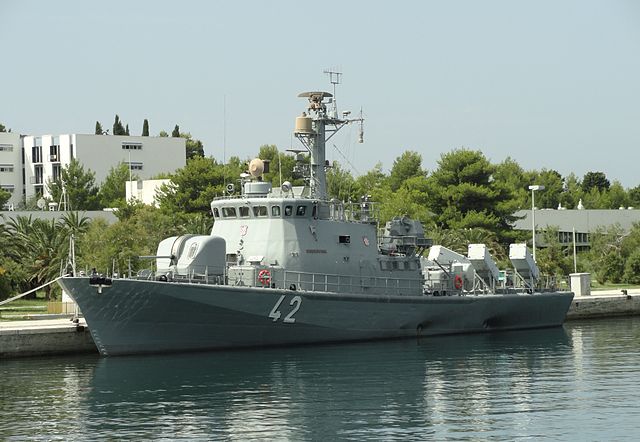
RTOP-42 Dubrovnik at Lora naval base
In 1991, after the federal Yugoslav armed forces sided with Serbia (Milošević) and started operations against the Croatian government, ethnically Croat naval officers and NCOs led by admiral Sveto Letica defected and started the creation of a Croatian Navy. They managed to create coastal artillery batteries forcing Yugoslav ships incursions in territorial waters. Soon also was created a commando multiplying actions, managing to seize naval equipment and no less than 35 vessels. In this process, they sunk three Yugoslav patrol boat in action, two minesweepers. The Croatian Navy thus did its part in the Croatian War of Independence (1991-1995) with its most prized possession being a stock of RBS-15B missiles.
In 1995 the Croatian Navy had 1080 personnel and controlled less than 20% of the former Yugoslavian Navy. On the other hand the Croatians took over almost all what was left of Yugoslavia’s pre-war merchant shipping. Out of 462 vessels of 3,293,447t gross reported in 1992, the Croatians in 1994 had 224 vessels of 192,682t, while the new Yugoslavia had to be satisfied with just nine ships of 2351t. To also put things in perspective, its needs were to be adequate to defend a coastal area of 1,777.3 kilometres (1,104.4 mi).
Ex-Yugoslavian ‘UNA’ class midget submarine:
Soca, taken over by Croatia in 1991.
Modified ‘UNA’ class midget submarines, probably modified Una class boats, lengthened to fit auxiliary diesel engine for charging batteries. Two laid down in Brodosplit in 1993. Diving depth 656ft (200m). Extant 1995.
Displacement: 98t submerged
Dimensions: 73ft 8in x 8ft 9in x 11ft 2in 22.5m x 2.7m x 3.4m
Machinery: Electric motors = 6kts
Armament: 2 Mala (R2) class SDVs or mines
Complement: 7
Ex-Yugoslavian ‘MALA’ class swimmer delivery vehicles:
Two captured by Croatia in 1992.
Ex-Yugoslavian “Type 201” fast attack craft (torpedo)
Class: Vukovar (51) Partizan III, ‘Shershen’ class boat built locally under licence in late 1960s, was taken over by the Croatian Navy in 1991 and renamed. Another of the class — Strelko — was heavily damaged when taken over in 1991 and beyond repair.
Ex-Soviet ‘OSA I’ class fast attack craft (missile)
Class: Dubrovnik (41, ex-Mitar Acev), Velimir Skorpik (42). Two of the class were taken over in 1991 by Croatians. The former was badly damaged, but repaired at Sibenik.
Ex-Yugoslavian ‘KONCAR’ (type 240) class fast attack craft (missile)
Viado Cvetkovtc was taken over by the Croatian Navy in 1991 and renamed Sibenic (no 21). She was followed possibly by another one.
KRALJ (Type 400) class fast attack craft (missile):
Class: Kralj Petar Kresimir IV (11, 1993, ex-Sergej Masera), 12 (1994). Laid down for Yugoslavian Navy in Kraljevica Shipyard as Kobra (Type 400) class and taken over in 1991 while on stocks. Kralj Kresiymir was launched 21 March 1992 and badly damaged in July 1993 when a missile accidentally exploded during loading. The mine rails can be substituted for further two missile launchers.
Displacement: 385t full load
Dimensions: 175ft 9in x 27ft 9in x 7ft 5in 53.6m x & 5m x 2.3m
Machinery: 3 shafts, 3 M504B 2 diesels, 12500hp = 36kts. Range 1500nm at 20kts
Armament: 4 Saab RBS15 SSM (2×2), 1-57mm Bofors, 1-30mm AK630, 2-20 Oerlikon, 6 mines
Sensors: Radar Racal BT502, BEAB 91V249, Racal 1290A; sonar RIZ PP 10M
Complement: 33
Ex-Yugoslavian MIRNA class patrol craft
Class: Biokovac (64), Hrvatska Kostajnica (63, ex-Cer), Solta (62, ex-Kozolo)
Taken over by Croatian Navy in 1991. When captured two of them were damaged (one by missile, another by torpedo), but they were eventually repaired.
Ex-French ‘SIRIUS’ class coastal minehunter:
Vukov Klanac, with upper deck heavily damaged in an air raid in autumn 1991, was taken over by the Croatians. Repaired and commissioned in Croatian Navy.
British ‘HAM’ class inshore minesweeper
“Iz” taken over by Croatia in 1991.
Ex-Yugoslavian ‘DTM 221’ class landing craft fuses 217 was taken over by Croatia in 1990 and renamed Jastreb. She was followed by 501 and two others in 1991.
Ex-Yugoslavian “Type 21’ landing craft: Four boats were captured in 1991 and commissioned with the Croatian Navy. Two more were damaged, but possibly also repaired and commissioned. Ex-Yugoslavian “Type 22’ landing craft Former Yugoslavian DJC 622 624 were taken over by the Croatians in 1991, , ae Dern Ms – are Ex-Yugoslavian ‘SILBA’ class landing ship/minelayer
Class: Cetina (81), Former Yugoslavian Ran was launched by Croatian Navy on 10 July 1992 in the Brodosplit Yard and commissioned into Croatian Navy on 19 February 1993.
The Croatian Navy today
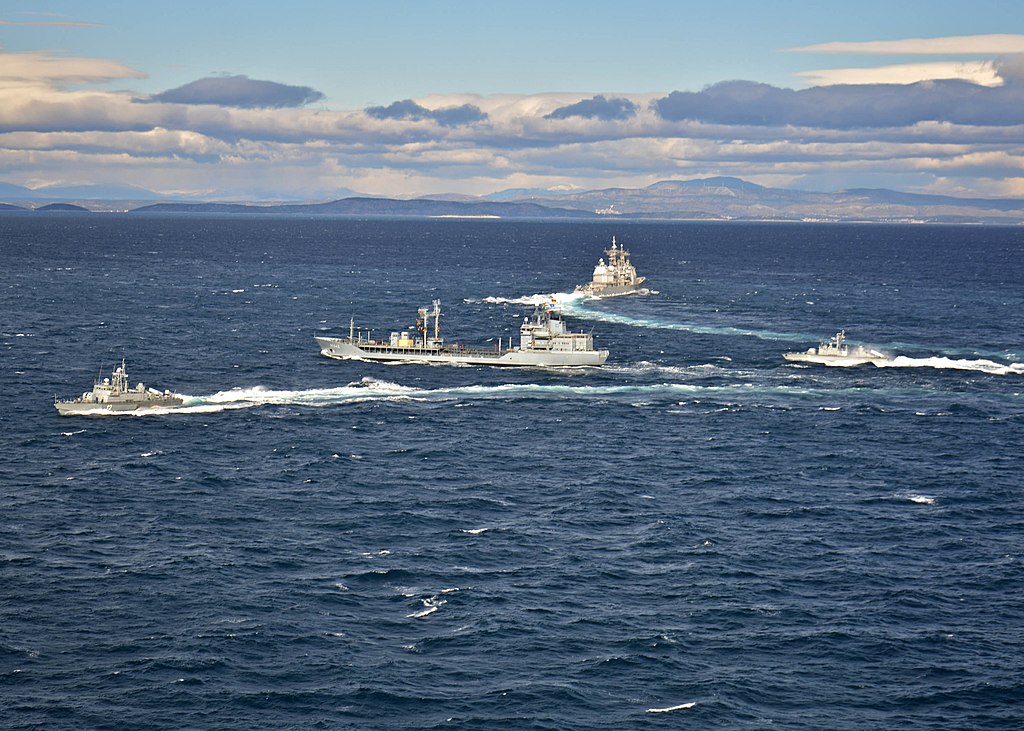
USS Vicksburg and German oiler Spessart in Adriatic manoeuvers escorted by Croatian FACs in 2015
In 2004 Croatia joined NATO, and new guidelines plus standardization brough a radical transformation. In 2007 personnel and vessels were dispatched to the newly created Coast Guard, still using assets of the Navy, no fully separated. The new Croatian navy acqired two former Helsinki class missile boats (FNS Oulu and FNS Kotka), renamed Vukovar and Dubrovnik, in service by December, 2008. Spare parts and three MTU engines came with this order, at a rather symbolic €9 million (offset deal for the acquisition of Patria AMV). Active from June, 2009 they were overhauled for “interception duties” by 2020.
There were also the Končar class missile boats. Šibenik was overhauled with new turbine engines and radars to be maintained until 2020. The Kralj class ships were scheduled for a €20 million overhaul, cancelled with the acquisition of the Helsinki class boats. RTOP-11 eventually obtained an auster overhaul/engine upgrade for €5 million and RTOP-12 followed.
As for the stock of RBS-15 missiles it was decided of an upgrade in 2014 for 20 units, completed by 2018 with successful live firing in 2015 and 2016, the first of such exercises since 1994.
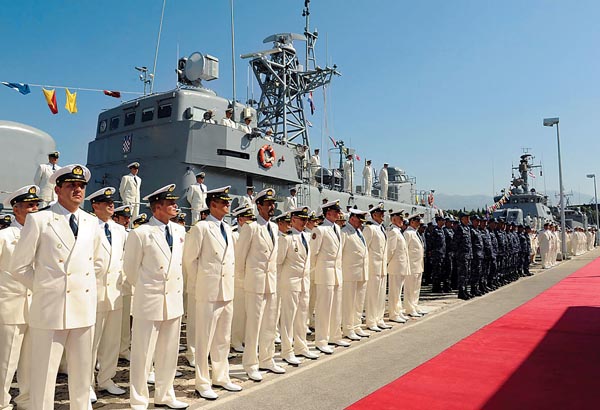
Ongoing or Future plans:
-Overhaul of the Kralj class fast attack craft at 70 million Croatian Kuna
-Overhaul and upgrade of Helsinki class for interception duties.
-Overhaul of training ship Andrija Mohorovičić (2024).
-Five brand new Omiš class patrol boats built for Coast Guard to replace the Mirna class. Cost 380 million Croatian Kuna. First laid down September 2015, delivered in 2018. Four in construction at Brodosplit shipyard.
-Salvage ship Faust Vrančić upgraded 2020 in Norway for ecological operations.
Organization:
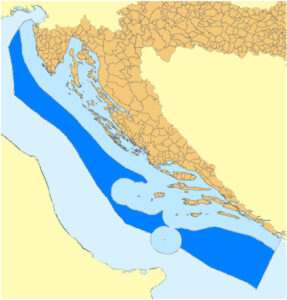 The flotilla is tasked for anti-ship and anti-submarine warfare, minelaying and mine countermeasures but also anti-terrorist activities and VIP transport. Its main HQ is in Lora naval base, Split. -Surface Action Squadron: 5 missile boats, 3 coastal mobile RBS-15 stations. See the lost below. Also two Cetina-class minelayer/landing ships took part in NATO’s “Trident Juncture” in Spain, 2015.
The flotilla is tasked for anti-ship and anti-submarine warfare, minelaying and mine countermeasures but also anti-terrorist activities and VIP transport. Its main HQ is in Lora naval base, Split. -Surface Action Squadron: 5 missile boats, 3 coastal mobile RBS-15 stations. See the lost below. Also two Cetina-class minelayer/landing ships took part in NATO’s “Trident Juncture” in Spain, 2015.
-Mine Countermeasures Squadron: Single mine-hunter (LM-51) and two REMUS autonomous underwater vehicles.
-Support Squadron with various tugs and auxiliaries split between harbours and bases.
–Naval infantry company based at Ploče
Split Naval Base: The Lora Naval Base, north of Split includes naval barracks and is tasked of all logistic support for the Pula (North Detachment) and Ploče (South) and hosts the Naval Training Center and medical center.
Sea Surveillance Battalion: It is organized to manage four Enhanced Peregrine naval radar posts at Lastovo, Dugi Otok, Mljet and Vis and nine GEM SC-2050XS naval radar posts at Savudrija, Brijuni, Mali Lošinj, Dugi Otok, Žirje, Vis, Lastovo, Mljet and Molunat as well as signals and communications.
Naval Academy: Rijeka unit, “Maršal Tito” Split academy for cadets, and NCO/petty officers training school in Šibenik.
Now all recruits must transit from the Croatian Military Academy in Zagreb and receive their specific naval education and training at Lora naval base, Split. From 2016 the Split University proposes and undergraduate 4-year program in naval engineering and seamanship.
Active ships list:
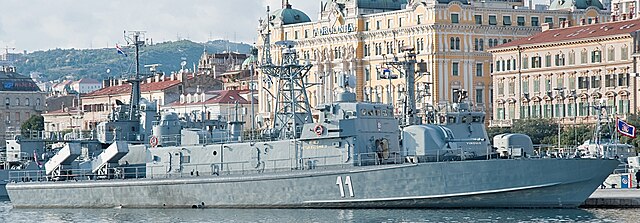
FAC Petar Kresimir
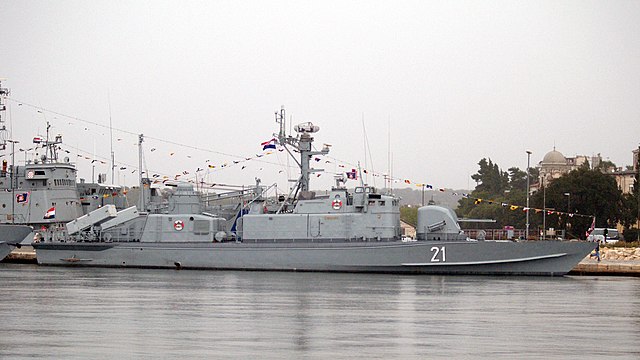
FAC Sibenik
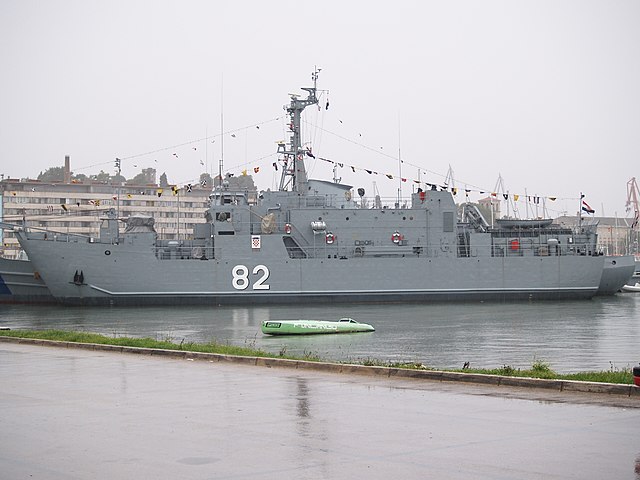
Minelayer Krka
-Končar class FACs: Šibenik RTOP-21
-Helsinki class FACs: Dubrovnik, Vukovar RTOP-41/42
-Kralj class FACs: Kralj Petar Krešimir, Kralj Dmitar Zvonimir (RTOP-11-12)
-Mirna class OPVs (1980): Novigrad, Šolta, Cavtat, Hrvatska Kostajnica (OB-01-04)
-Omiš class (OB-31, 2018, 2020+) new class of 5 designed by Marine and Energy Solutions DIV d.o.o. Zagreb, Brodosplit.
-Training ship: Moma class, Andrija Mohorovičić (BŠ-72) 1972, still active
-Rescue vessel: Spasilac class Faust Vrančić (BS-73), 1974, same
-180t Minehunter orčula (LM-51, 2006)
-540 tonnes lba class Landing ship & minelayers: Cetina, Krka (DBM-81-82, 1993)
-Landing ship & assault ships Type 11 DJB-104 (1977) Type 22 DJB-106, DJB-107 (1978) and PDS-713
-310t Auxiliary cargo Meduza PT-71 (1956)
-Government’s yachts Učka, Čista Velika
-Launches: Diving support launch MRB-83, MRB-51, Transport-ceremonial launch Krasnica
-Harbour tugboat LR-71, LR-73
-Sailboats Salona 37 & 45 Katarina Zrinska, Kraljica Jelena
Croatian Coast Guard
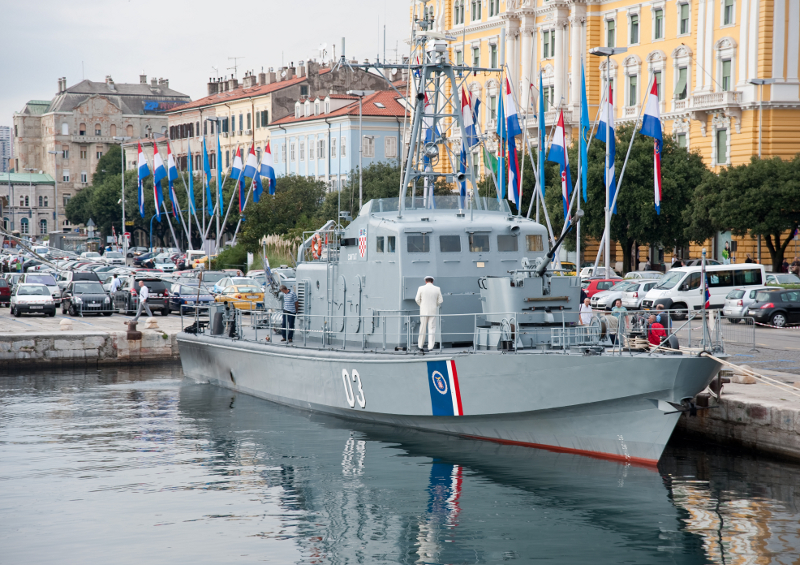
Cavtat of the Mirna class
The Coast Guard (2007) is tasked of traditional EEZ and fishery protection, environmental protection, tankers and ballast waters control as well as anti-terrorist activities and anti-narcotics/trafficking patrols. It is placed under the jurisdiction in the Ecological and Fisheries Protection Zone on the Adriatic continental shelf and high seas. It comprises the following:
-Training ship BŠ-72 Andrija Mohorovičić (takes part in Operation Triton off Sicily)
–1st Coast Guard Squadron (Split): Mirna class patrol boats and other smaller ships
–2nd Coast Guard Squadron (Pula) northern Adriatic: two Mirna-class patrol boats and other smaller ships.
–Naval Air force: Four detached Air Force Mil Mi-8MTV-1 helicopters based at Divulje airfield, two Pilatus PC-9 based at Zemunik Air Base for SAR and support/patrol.
Sources
Official Website
navaltoday.com 2018 omis
mes.divgroup.eu
osrh.hr/
navalpost.com/ omis-class
skveranka.com
en.wikipedia.org Croatian_Navy
 Cuban Navy
Cuban Navy
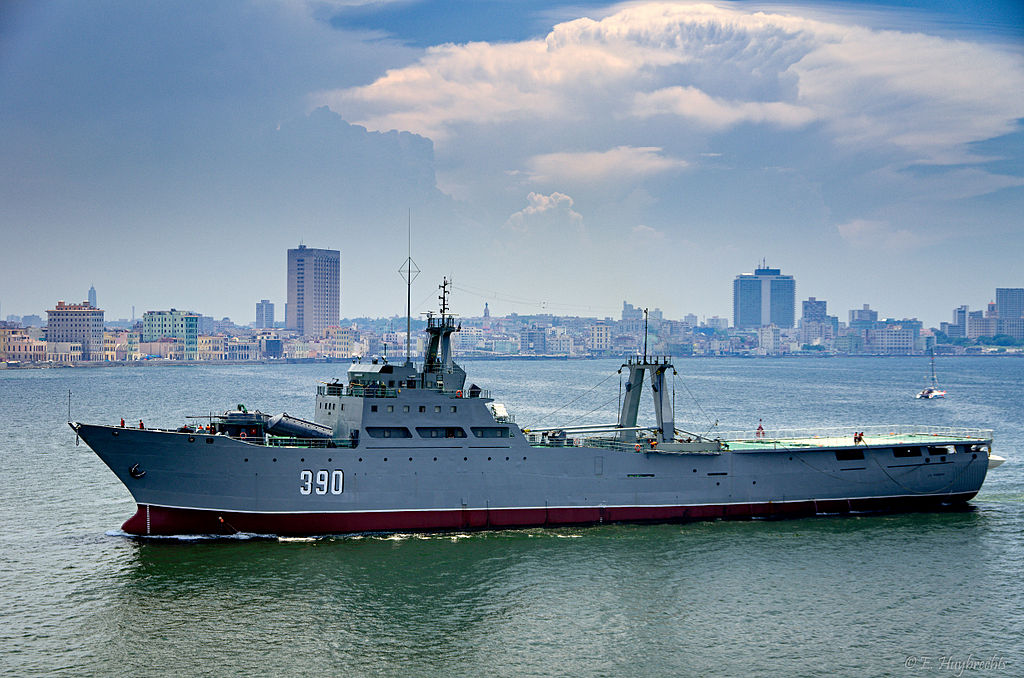
Rio Dalmuji, a home-built converted trawler, missile and helicopter ship.
There is no “cuban navy” per se before the Castrist revolution of 1959-60. It is estimated that its Pre-Columbian era started with the first human colonies settling in around 6000 BC alongside the migrations to the south americas. The earliest civilisation were the Arawakan-speaking ancestors of the Taino people. Famously the island was discovered by Christopher Columbus on 27 October 1492, landing in its northeastern coast the following day; but he did not settled in, whereas 1511 saw the first Spanish settlement, founded by Diego Velázquez de Cuéllar, at Baracoa. Other followed and it became the Captaincy General of Cuba, one of the most profitable assets of the Spanish Empire for centuries. Fast forward to the events of 1898, there was a Cuban insurgency against Spanish rule already brewing in the 1870s but it really began to grow in the 1890s. US agenda at the time and the brutal repression in the Islands reported by a “yellow press” took another dimension when USS Maine was sunk in La Habana, when dispatched to safeguard US interest in the city. What followed after smome time was a declaration of war and the first US expeditions, both in the Philippines and Cuba.
Fast forward and Cuba gained semi-independence in 1902, under the Republic of Cuba (1902–1959). It was a protectorate in which US companies soon replaced the former Spanish planters. Growing discontent after the military coup and under the brutal regime of Fulgencio Batista from 1933. During WW2 Cuba, which operated four old gunboats, lost six merchant ships but claimed the German submarine U-176.
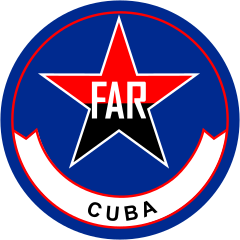 Ramon Grau San Martin was elected president in 1944, but Batista returned with a coup (suported by the US) in 1952. Various organization attempted an armed uprizing, but the most famous started with Fidel Casto’s 80 supporters landing from the yacht Granma. In 1958 his July 26th Movement emerged as the leading revolutionary group, supported by the US embargo. Heentered the Patital Havana on 8 January 1959.
Ramon Grau San Martin was elected president in 1944, but Batista returned with a coup (suported by the US) in 1952. Various organization attempted an armed uprizing, but the most famous started with Fidel Casto’s 80 supporters landing from the yacht Granma. In 1958 his July 26th Movement emerged as the leading revolutionary group, supported by the US embargo. Heentered the Patital Havana on 8 January 1959.
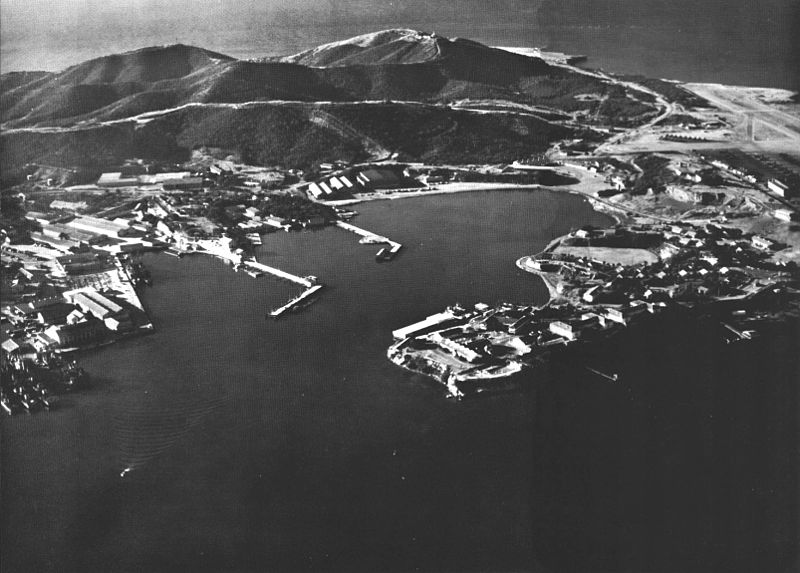
Guantanamo Base in 1862
The liberal Manuel Urrutia Lleó became provisional president, however soon Castro’s legalization of the Communist Party, hundreds of executions of Batista agents started to degrade relations between countries, but the Agrarian Reform Law really took the cake leading the US to imposed a range of sanctions between 1960 and 1964, with in between the famous “Cuban Crisis”, the deployment of soviet strategic medium range ballistic missiles in Cuba after the failed Bay of Pigs Invasion. This trigerred an embargo, which pitted against dangerously closely Soviet submarines and US escorts.
Eventually Soviet-US contacts and an agreement led to desescalation. The missiles were retired (to the dismay of Castro) in exchange of similar retirement of Turkey’s missiles, and the lift of the embargo. Ever since however, the Castrists regime has been seen as a threat to US interests in the Carribean. Now how about the Cuba navy in the cold war ?
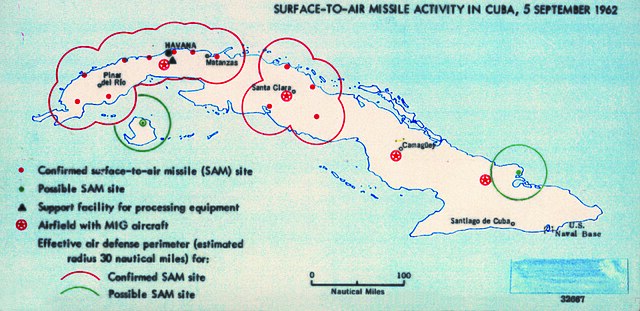
Map of the Cuban missiles in 1962, US Intel
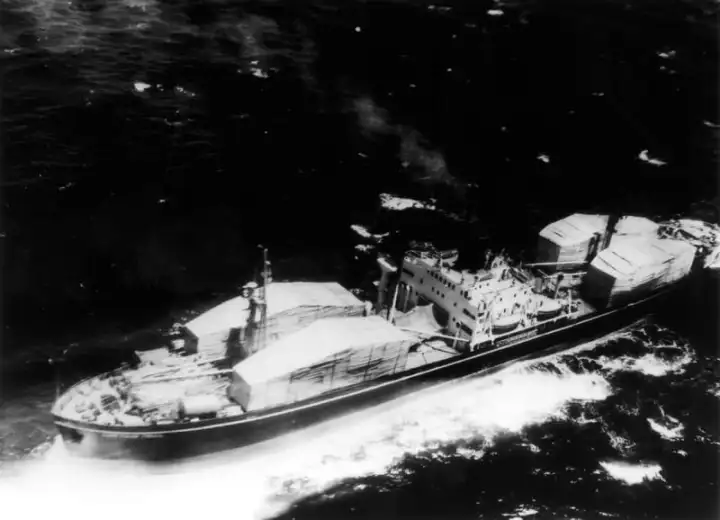
Soviet Cargo carrying for Komar class missile fast attack craft to Cuba during the embargo in 1962 (US DoD).
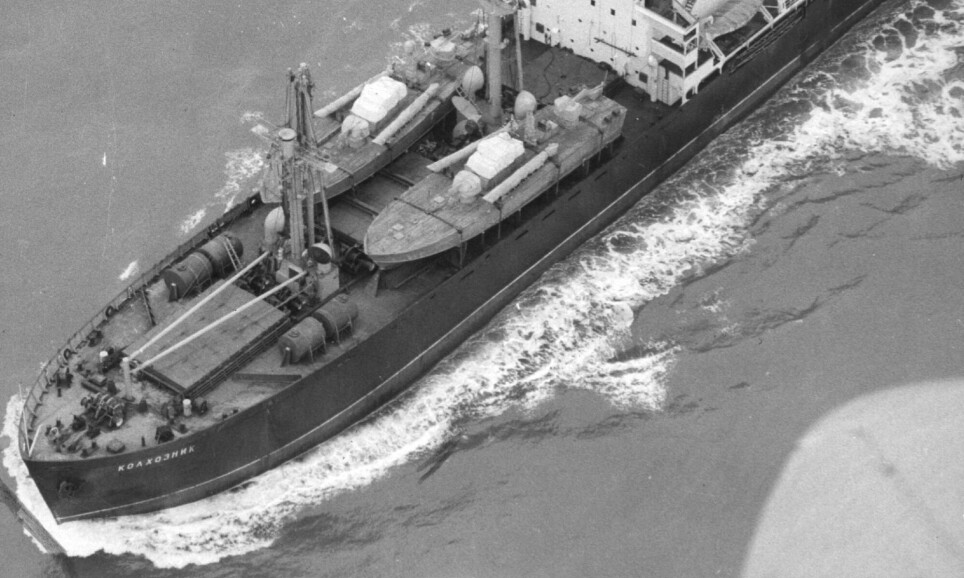
Soviet cargo carrying P4 fast attack crafts to Cuba, same.
Marina de Guerra Revolucionaria
 Initially, Cuba was provided a lot of Soviet armament, for its land systems (tanks and AFVs), artillery, small arms and advanced SAM systems. The FAR or Fuerzas Armadas Revolucionarias was a collection of organizations, the Revolutionary Army, Revolutionary Navy, Revolutionary Air and Air Defense Force, paramilitary bodies such as Territorial Troops Militia, Youth Labor Army, Defense and Production Brigades, Civil Defense Organization and National Reserves Institution. For the remainder of the cold war the Castrist regime indeed feared a new US operation. The FAR led operations in Africa against “Imperialist interests” and former colonial powers, notably in Angola.
Initially, Cuba was provided a lot of Soviet armament, for its land systems (tanks and AFVs), artillery, small arms and advanced SAM systems. The FAR or Fuerzas Armadas Revolucionarias was a collection of organizations, the Revolutionary Army, Revolutionary Navy, Revolutionary Air and Air Defense Force, paramilitary bodies such as Territorial Troops Militia, Youth Labor Army, Defense and Production Brigades, Civil Defense Organization and National Reserves Institution. For the remainder of the cold war the Castrist regime indeed feared a new US operation. The FAR led operations in Africa against “Imperialist interests” and former colonial powers, notably in Angola.
Today the CRN (Cuban Revolutionary Navy) whih took its roots in the former Spanish-controlled naval forces created in 1909, is 3500 personal strong, c30-35 vessels including missile-launching ones and submarines, “special weapons” and marines, batallions and regiments, plus a small naval aviation contingent. It’s a green water navy, but with some regional importance, as one of the strongest in the Carribean. It’s procurement remained ex-Soviet or even North Korean.
The MGR in 1990
The pre-Castro Cuban Navy was totally dependent upon the United States. Since independence at the turn of the century, Cuba, politically and militarily, had been dominated by American policies. The ficet reflected this. In 1959 the Cuban Navy was composed of exUS warships, most of which had been built during the Second World War. Many of these were comparatively larger types such as Tacoma class frigates; their equipment was old and the ships were not well maintained. Many of these ships were built as ASW platforms and much of the US training aid was in this speciality. This force was illsuited for a war against Castro’s guerrilla forces and reflected the ultra-conservative doctrines of both the Juan Batista military and the American advisers, although the Cuban Navy had a history of political involvement. The assumption and resumption of power by Juan Batista brought with it purges of the officer corps of all services and a resulting loyalty to the regime — as well as a lack of military professionalism and poor leadership.
During the years immediately preceding Fidel Castro’s emergence the navy was increasingly restless, and accordingly harassed by the Batista forces. Like all Latin American navies, the Cuban Navy was conservative. Officers were generally from the middle or lower upper class. Naturally, a group with this background must come to odds with the Castro leadership. In July 1959, Raul Castro, Commander-in-Chief of the Armed Forces, assigned thirty-six politically indoctrinated army officers to the navy. In September the Marine Corps was ordered to be dissolved. The cohesiveness of the navy was diluted by assigning personnel, including ships’ crews, to various construction projects, mainly the improvement of transit facilities.
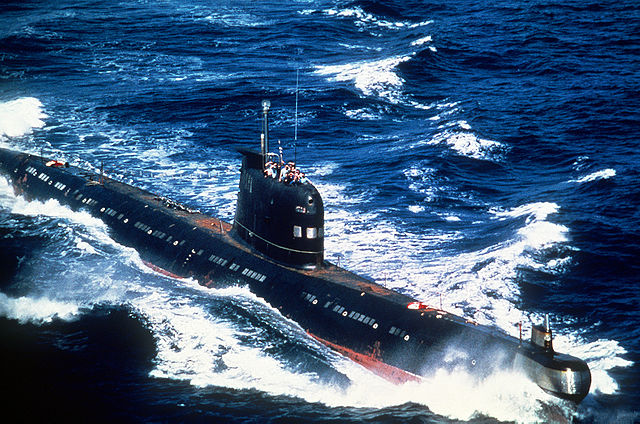
Cuban Foxtrot class sub, photo taken in the 1980s. This decade saw the Cuban Navy assuredly being the largest East Indies Navies by far.
The new Cuban Navy was as dependent upon the Soviet Union as the old one had been upon the United States. Since 1962 the backbone of the fleet has been guided missile patrol boats. In fact, these were the first such craft in the Western Hemisphere. These missile boats have been supplemented by other patrol craft. Soviet naval aid took on far greater dimensions with the transfer of submarines, beginning in 1979 and continued with Soviet financial aid. A ‘Koni’ class frigate was transferred in 1981, with two more following in 1984 and 1988.
Cuba’s greatest maritime asset is her strategic location. The long-rumoured Soviet submarine base at Cienfuegos brought this painfully into focus. This key location married to Fidel Castro’s professed desire to export revolution and his willingness to act as a Soviet surrogate, made the Cuban Navy one of the most important in the Western Hemisphere, despite its relatively small size. Main naval bases are at Canasi, Cienfuegos, Havana, Mariel and Punta Ballenatos; 13,500 officers and men, including 1,000 marines, serve with the Cuban Navy and there is a three-year period of national service.
Currently probably all acquisitions of new material for the navy will be stopped owing to the country’s grave economic crisis, and difficulties will be encountered with maintenance of the existing ex-Soviet equipment, as no aid from Russia is expected. All this will undoubtedly lower the level of efficiency of the naval forces.
Fleet strenght in 1947:
-Cuba (sloop) (10.8.14) 2,055t Discarded 1971
-Patria (sloop) (10.8.11) 1,200t Discarded 1955, she operated as training ship until the end of her service.
-Baire (gunboat) 1906 500t, discarded 1948
There were also a number of coast guard patrol craft:
-The Cuban-built Leoncto Prado (80t, 1946)
-Ex-US type Camaguey Habana, Las Villas, Oriente and Pinar del Rio
-45t ex-US Coast Guard GC 11 14, 22, 32 34.
-Donativo (130t, 1932), Matanzas (80t, 1912).
-Three US-built Vosper type MTBs (R 4/R 43) were employed as air-sea rescue vessels.
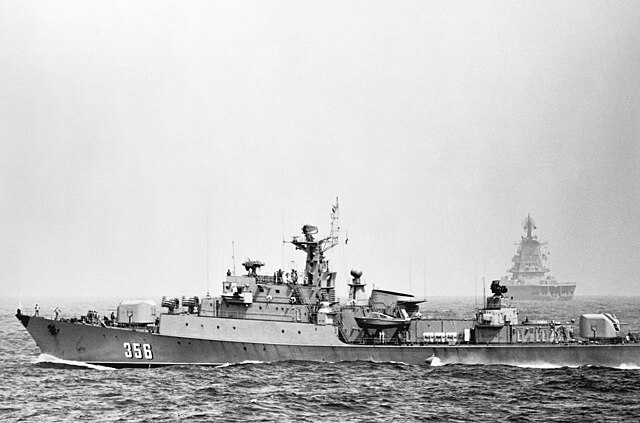
Ex-Soviet KONI (Pr. 1159) class frigates:
350, 353, 356: Three ‘Koni’ (Type 1159) frigates were transferred on 24 September 1981, 8 February 1984 and 10 April 1988 respectively. These ships are said to have no names, however the name Marie] was mentioned in connection with the first unit. They are similar to the Algerian version of the type with continuous superstructure. Two of them are usually based at Mariel. These are the most important units of the small Cuban Navy, extant 1995.
Ex-Soviet FOXTROT (PR. 641)
Submarines Class: 725, 727, 729: Three large patrol submarines of Soviet Project 641, transferred in 1979, 1980 and 1984 respectively.
Submarines No 725 and 727 were under refit at Havana as of 1991.
Ex-Whiskey class
The Cuban navy also received one ‘Whiskey’ (Type 613) submarine in 1979, non-operational; used as battery charging station.
Ex-Soviet ‘POLNOCNY B’ (Type 771):
Landing ships Class: 690, 691 ; ; Two ‘Polnocny B’ (Type 771) landing ships built by Stocznia Polnocna in Gdansk, Poland were transferred by the Soviet Navy in September and December 1982. Extant 1995.
Ex-Polish ‘EICHSTADEN’ (Type 709):
Landing crafts, Two LCPs of Polish Type 709 transferred from Poland in 1990, probably to replace the last craft of the Soviet ‘T 4’ class. Cuba operates seven ‘T 4’ class LCMs which are used for harbour duties.
Ex-US TACOMA class patrol escorts Class:
Antonto Maceo (ex-Peoria, 1947), Jose Marti (ex-Eugene, 1947), Maximo Gomez (ex-Grand Island, 1947)
All units modernised 1956 at Key West, Florida; all discarded 1975. Fose Mart fitted as a flagship and sunk as a target 1975, Ex-US PCE class patrol escort Class (transfer date): ; Caribe (ex-PCE 872, 1947), Siboney (ex-PCE 893, 1947) Both units modernised 1956 at Key West, Florida. Caribe had box deckhouse removed 1953. Discarded 1976 and 1973 respectively.
Ex-Soviet ‘PAUK IT’ (Type 1241.2) class corvette:
One ‘Pauk IT’ clase corvette built by Varodav SY, transferred in May 1990, More Transfer of following units slowed of halted probably due to the financial difficulties of both parties. Similar to the ships serving in Indian Navy, extant, 2 in 1995, 1981,
Ex-Soviet ‘KOMAR’ (Type 183-R) class fast attack craft (missile):
Eighteen units transferred twelve tn 1962, four during 1963 66, two in 1967; Four discarded in 1979. Nine deleted 1982 84 and the rest by 1990
Ex-Soviet ‘OSA I (Type 205) class fast attack craft (missile):
Transferred owo in 1972, two in 1973 and wwo in 1974, One unit deleted tn 1981. Five extant 1995
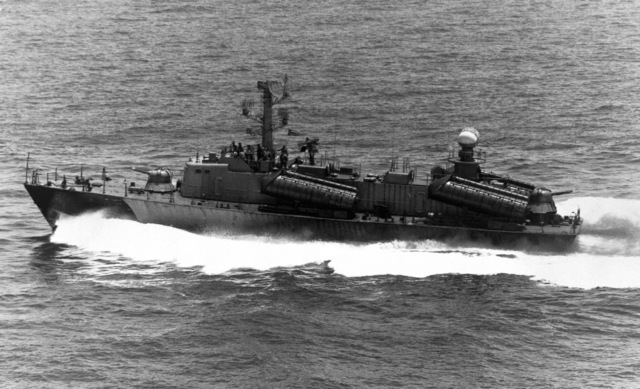
Ex-Soviet ‘OSA IP (Type 205-M) fast attack craft (missile):
Thirteen units traneferred – two in 1976, one in 1978, four in 1979, two in 1981 and four in 1982. All units extant 1995.
Ex-US PC type submarine chaser:
Ex-Tribesman, ex-PC 790. Acquired from Honduras in 1956 and rearmed; sank at dock, Isle de Pines, 17 April 1961 during an abortive coup.
Ex-Soviet ‘KRONSTADT’ (Type 122-bis) class:
Six Large patrol crafts towed by merchant ships to Cuba in February 1962; two units discarded in 1979 and the other four in 1984.
Ex-Soviet ‘SO 1’ (Type 210-M) class large patrol craft:
Twelve units; six transferred in 1964 and six in 1967; qwo discarded 1979, one in 1981, three in 1984, nwo in 1985, two in 1990 and two by 1992.
Ex-Soviet ‘P 6’ (Type 183) class fast attack craft:
Twelve units towed by merchant ships to Cuba in 1962; six units discarded 1979; six discarded 1985. Depth charge and mine carrying capabilities.
Ex-Soviet ‘P 4’ class fast attack craft (torpedo):
Twelve units wansferred 1962-64. Seven deleted in 1984, five in 1985. Ex-Soviet ‘TURYA’ (Type 206-M) fast attack craft (hydrofoil) Class: 101, 102, 108, 112, 130, 165, 178, 180, 193.
Two units rransferred in 1979, two in 1980, two in 1981, two in 1983 and the last one in November 1983. Fitted with four torpedo tubes. All extant 1995.
Ex-Soviet ZHUK (Type 199) class coastal patrol craft:
A total of forty of these small patrol craft were transferred from Soviet Union since 1971, the last in 1989. Few have been deleted since. About twenty-seven extant 1995. Used by Coast Guard, pennant numbers painted in red.
Ex-Soviet STENKA (Type 205-E) class fast attack craft (patrol):
Two of these craft were wansferred from the USSR in February 1985 and one in August 1985. Similar to the units used by KGB, but with TTs and sonar removed. Extant 1995.
Ex-Soviet SONYA (Type 1265) class minesweepers:
Two units transferred in August and December 1980, two in January and December 1985. Pennant numbers 560, 561, 571, 578. Extant 1995.
Ex-Soviet YEVGENYA (Type 1258) class minesweepers:
Class: 501-504, 507-509, 501-514, 538. Two transferred 1977, one 1978, two 1980, two 1981, one 1982, four 1984, organized into squadrons, extant 1995.
Ex-Polish K8 (Type 361T):
One transferred 1978, apparently in such state she was discarded in 1982.
The MGR Today
 In 1988, the Cuban Navy boasted 12,000 men, three submarines, two modern guided-missile frigates, one intel vessel, and a large number of patrol craft, minesweepers but these fleet had been decommissioned or sunk as artificial reefs. By 2007, the Cuban Navy was down to just 3,000 strong (550 Navy Infantry) and its missile force reduced to just a single Pauk-class corvette and six Osa-II. The main reason were US economic sanctions and the regime’s poor economic management in general, leading to drastic budget reduction as well as a more recent normalisation of relations with the US from On 17 December 2014 Obama’s re-establishement of diplomatic relations, but it was reverted under the Trump adm. and reinforced under Biden. China is today the major partner for Cuba and could well provide its future naval assets if the economy’s recovering. Previously 10%, the armed forces represents now 2.9% of its GDP.
In 1988, the Cuban Navy boasted 12,000 men, three submarines, two modern guided-missile frigates, one intel vessel, and a large number of patrol craft, minesweepers but these fleet had been decommissioned or sunk as artificial reefs. By 2007, the Cuban Navy was down to just 3,000 strong (550 Navy Infantry) and its missile force reduced to just a single Pauk-class corvette and six Osa-II. The main reason were US economic sanctions and the regime’s poor economic management in general, leading to drastic budget reduction as well as a more recent normalisation of relations with the US from On 17 December 2014 Obama’s re-establishement of diplomatic relations, but it was reverted under the Trump adm. and reinforced under Biden. China is today the major partner for Cuba and could well provide its future naval assets if the economy’s recovering. Previously 10%, the armed forces represents now 2.9% of its GDP.
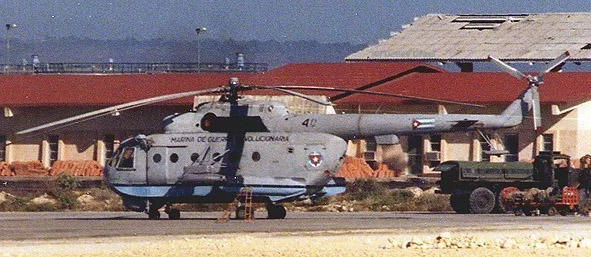
Cuban naval air wing today is composed of two MI-14 Haze ASW helicopters. src
The Cuban Navy created its own missile systems: The Bandera (copy of the Styx missiles) and Remulgadas, as well as the Frontera self-propelled coastal defence multiple rocket launcher. The Navy today’s missions are mostly drug smuggling and illegal immigration prevention. Indeed her dwindling naval presence enabled traffickers to use its territorial waters or airspace.
-2 Rio Damuji-class frigates:
Former armed fishing trawlers, Spanish-built stern trawlers, locally reshaped to have a helicopter landing deck and weaponry, 3,200 tons. 1× 57 mm (former tank gun), 2 Styx (Silkworm) surface-to-surface missiles, 1× 12.7 mm machine gun, 2× 25 mm autocannons.
-1 Delfin-class submarine:
2 torpedo launchers, possibly North Korean Yugo-class derived design.
-1 Pauk II-class fast patrol corvette:
495 tons, 1× 76 mm gun, 4 anti-submarine torpedo tubes, 2 anti-submarine weapon rocket launcher
-6 former Osa II-class PFM missile boats
-3 Sonya-class minesweepers
-5 Yevgenya-class minesweeper
-1 Intelligence collection vessel
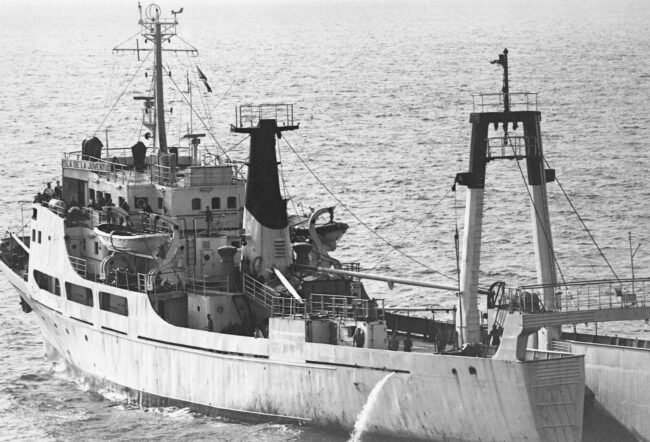
Port quarter view of a Cuban intelligence collector (AGI) Isla De La Juventud. src
Border Guards:
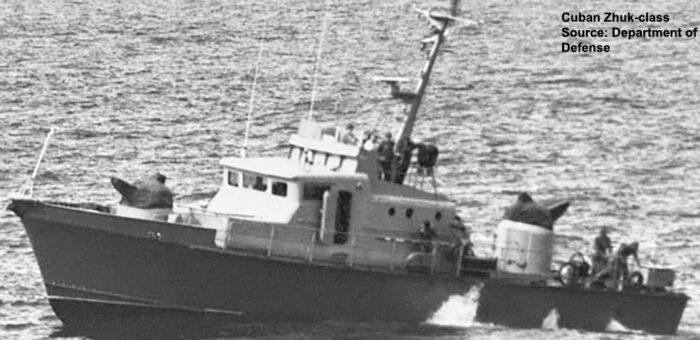
Cuban Zhuk class Cabo Verde, US Intel DoD src
2x Stenka class patrol boats 4 boats aquired in 1985, only gun-armed.
12x Zhuk patrol craft, with SPG-9 mounted on front of the twin 30mm guns.
Rumored special ops assets:
According to HI Sutton (http://www.hisutton.com/) working in OSINT, outside the Delfin, the navy’s best underwater assets could be a serie of unmanned pontoons carrying a single torpedo tube. Made for harbour operations, painted black,very low on water and using a creeping or electric engine.
In 2013 were reevaled also a serie of spec ops minisubs, comparable to the SEAL Delivery Vehicles (SDVs)
Also recently satelite images revealed a mystery improvised torpedo boat, speedboat with torpedoes.
Marine Ground forces:
piccccc
Cuban Marine PT-76 amphibious light tank
2x amphibious assault battalions.
1x coastal defense field artillery regiment
1x coastal defense missile artillery regiment
1x light armored battalion (amphibious)
Assets: 122 mm M-1931/3 artillery 130 mm M-46 artillery, 152 mm M-1937 artillery, 10x SSC-3 surface-to-surface missile systems, c18–24 Remulgadas coastal defense surface multiple missile launchers, 20 Bandera coastal defense surface multiple missile launchers, 12 RBU-6000 Frontera coastal defense multiple rocket launchers, c18–22 PT-76 light tanks.
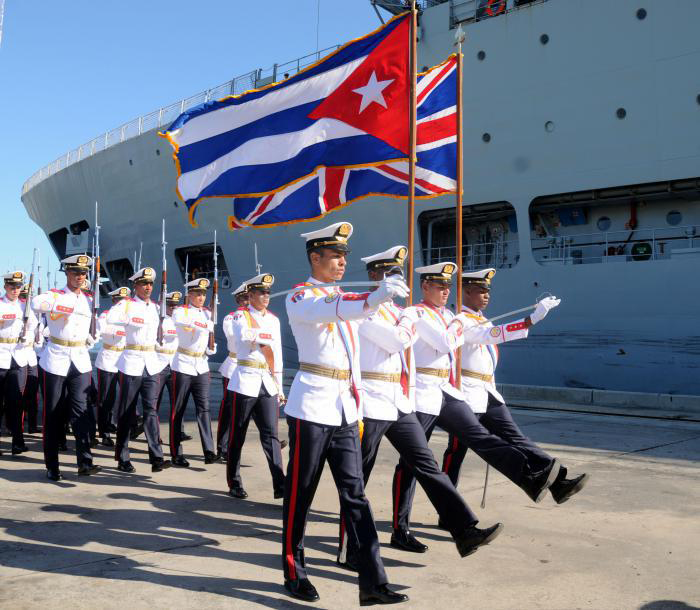
Cuban parade in honor of RN HMS Wave Knight RFA arrving in La Havana src
Sources
forbes.com Cuban special weapons
Cuba’s swimmer delivery vehicle
Delfin Class Submarine
news.usni.org tag cuban-navy
navypedia.org
globalsecurity.org cuban unit
globalsecurity.org/ cuban navy
cubapolidata.com cafr_airforce.html
theatlantic.com/ cuba-havanas-military-machine
image forbes.com spec ops cuban navy
granma.cu/ un-baluarte-sobre-el-mar
minfar.gob.cu grados-militares
globalsecurity.org rio-damuji.htm
The Decline of the Cuban Armed Forces
Cuban Revolutionary Navy
 Djibouti Navy
Djibouti Navy
 Dominican Republic Navy
Dominican Republic Navy
 Equadorian Navy
Equadorian Navy
 Estonian Navy
Estonian Navy
 Ethiopian Navy
Ethiopian Navy
 Finnish Navy
Finnish Navy
 Georgian Navy
Georgian Navy
 Haitian Navy
Haitian Navy
 Honduras Navy
Honduras Navy
 Icelandic Navy
Icelandic Navy
 Iraqi Navy
Iraqi Navy
 Jordanian Navy
Jordanian Navy
 Kuwaiti Navy
Kuwaiti Navy
 Latvian Navy
Latvian Navy
 Lebanese Navy
Lebanese Navy
 Liberian Navy
Liberian Navy
 Libyan Navy
Libyan Navy
 Lithuanian Navy
Lithuanian Navy
 Mauritanian Navy
Mauritanian Navy
 Mexican Navy
Mexican Navy
 Morrocan Navy
Morrocan Navy
 Nicaraguan Navy
Nicaraguan Navy
 Norwegian Navy
Norwegian Navy
 Omani Navy
Omani Navy
 Pakistani Navy
Pakistani Navy
 Paraguaian Navy
Paraguaian Navy
 Qatari Navy
Qatari Navy
 San Salvador Navy
San Salvador Navy
 Saudi Navy
Saudi Navy
 Serbian Navy
Serbian Navy
 Singaporean Navy
Singaporean Navy
 Slovenian Navy
Slovenian Navy
 Somalian Navy
Somalian Navy
 Sudanese Navy
Sudanese Navy
 Syrian Navy
Syrian Navy
 Thai Navy
Thai Navy
 Tunisian Navy
Tunisian Navy
 UAE Navy
UAE Navy
 Uruguayan Navy
Uruguayan Navy
 Venezuelan Navy
Venezuelan Navy
 Vietnamese Navy
Vietnamese Navy
 Yemeni Navy
Yemeni Navy
 Zanzibar Navy
Zanzibar Navy

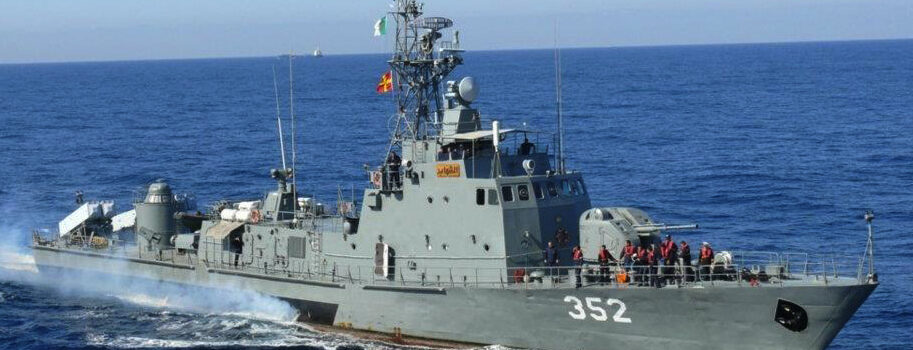
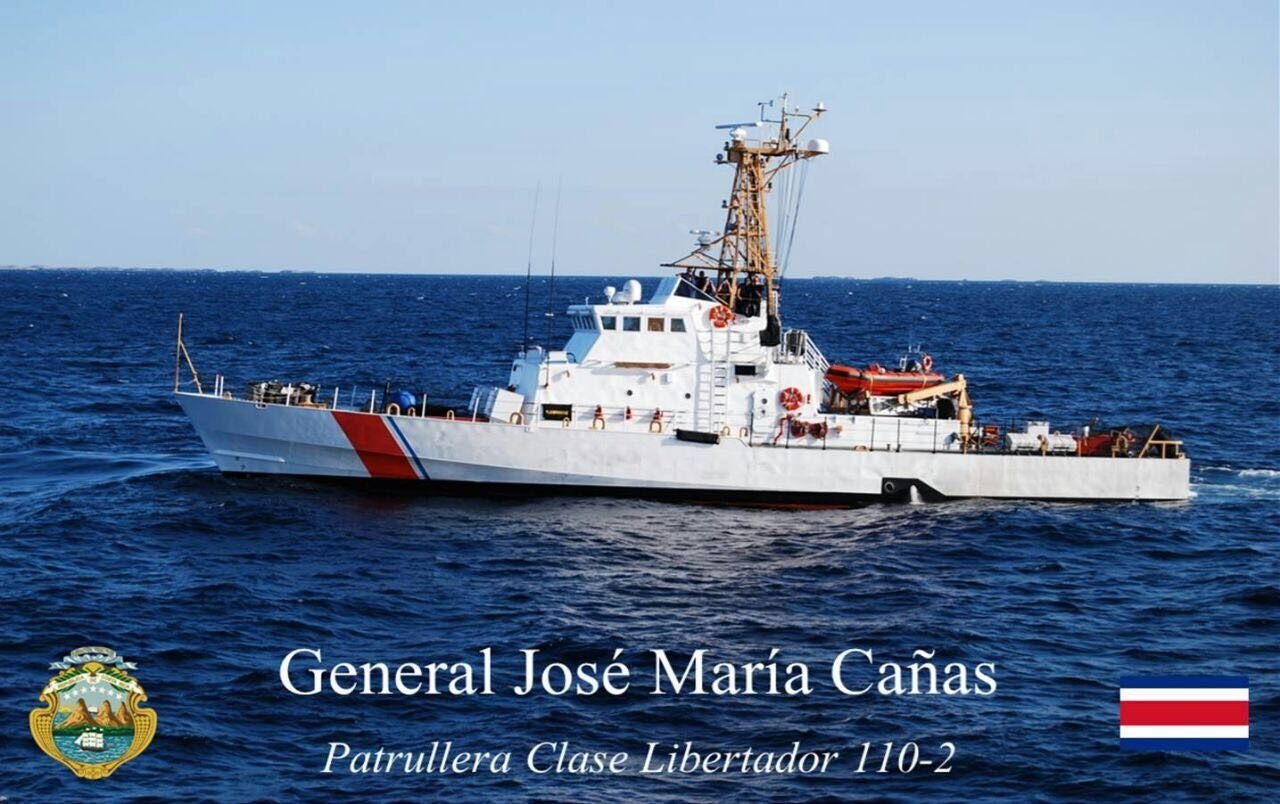
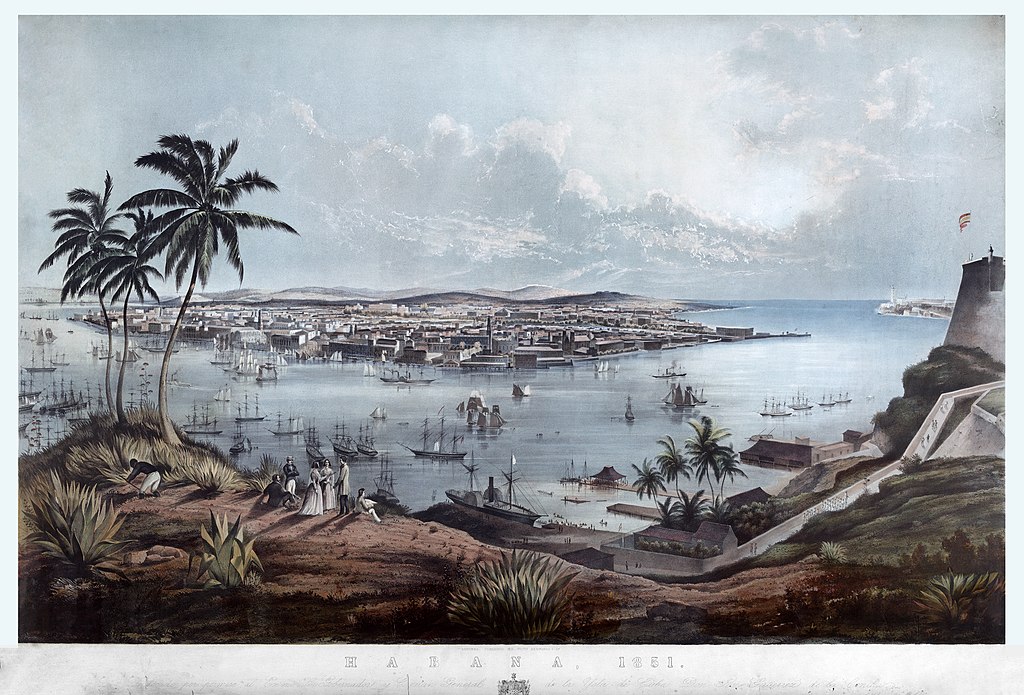
 Latest Facebook Entry -
Latest Facebook Entry -  X(Tweeter) Naval Encyclopedia's deck archive
X(Tweeter) Naval Encyclopedia's deck archive Instagram (@navalencyc)
Instagram (@navalencyc)





 Austrian Navy
Austrian Navy French Navy
French Navy Royal Navy
Royal Navy Armada Espanola
Armada Espanola K.u.K. Kriegsmarine
K.u.K. Kriegsmarine Dansk Marine
Dansk Marine Nautiko Hellenon
Nautiko Hellenon Koninklije Marine 1870
Koninklije Marine 1870 Marinha do Brasil
Marinha do Brasil Osmanlı Donanması
Osmanlı Donanması Marina Do Peru
Marina Do Peru Marinha do Portugal
Marinha do Portugal Regia Marina 1870
Regia Marina 1870 Nihhon Kaigun 1870
Nihhon Kaigun 1870 Preußische Marine 1870
Preußische Marine 1870 Russkiy Flot 1870
Russkiy Flot 1870 Svenska marinen
Svenska marinen Søværnet
Søværnet Union Navy
Union Navy Confederate Navy
Confederate Navy Armada de Argentina
Armada de Argentina Imperial Chinese Navy
Imperial Chinese Navy Marinha do Portugal
Marinha do Portugal Mexico
Mexico Kaiserliche Marine
Kaiserliche Marine 1898 US Navy
1898 US Navy Russkiy Flot
Russkiy Flot French Naval Aviation
French Naval Aviation Russian Naval Aviation
Russian Naval Aviation Sovietskiy Flot
Sovietskiy Flot Royal Canadian Navy
Royal Canadian Navy Royal Australian Navy
Royal Australian Navy RNZN Fleet
RNZN Fleet Chinese Navy 1937
Chinese Navy 1937 Kriegsmarine
Kriegsmarine Chilean Navy
Chilean Navy Danish Navy
Danish Navy Finnish Navy
Finnish Navy Hellenic Navy
Hellenic Navy Polish Navy
Polish Navy Romanian Navy
Romanian Navy Turkish Navy
Turkish Navy Royal Yugoslav Navy
Royal Yugoslav Navy Royal Thai Navy
Royal Thai Navy Minor Navies
Minor Navies Albania
Albania Austria
Austria Belgium
Belgium Columbia
Columbia Costa Rica
Costa Rica Cuba
Cuba Czechoslovakia
Czechoslovakia Dominican Republic
Dominican Republic Haiti
Haiti Hungary
Hungary Honduras
Honduras Estonia
Estonia Iceland
Iceland Eire
Eire Equador
Equador Iran
Iran Iraq
Iraq Latvia
Latvia Liberia
Liberia Lithuania
Lithuania Mandchukuo
Mandchukuo Morocco
Morocco Nicaragua
Nicaragua Persia
Persia San Salvador
San Salvador Sarawak
Sarawak Uruguay
Uruguay Venezuela
Venezuela Zanzibar
Zanzibar Warsaw Pact Navies
Warsaw Pact Navies Bulgaria
Bulgaria Hungary
Hungary

 Bundesmarine
Bundesmarine Dutch Navy
Dutch Navy Hellenic Navy
Hellenic Navy Marina Militare
Marina Militare Taiwanese Navy
Taiwanese Navy Chinese Navy
Chinese Navy Indian Navy
Indian Navy Indonesian Navy
Indonesian Navy JMSDF
JMSDF North Korean Navy
North Korean Navy Philippines Navy
Philippines Navy ROKN
ROKN IDF Navy
IDF Navy Royal New Zealand Navy
Royal New Zealand Navy Egyptian Navy
Egyptian Navy South African Navy
South African Navy

































 RN
RN
 Marine Nationale
Marine Nationale
 Soviet Navy
Soviet Navy
 dbodesign
dbodesign